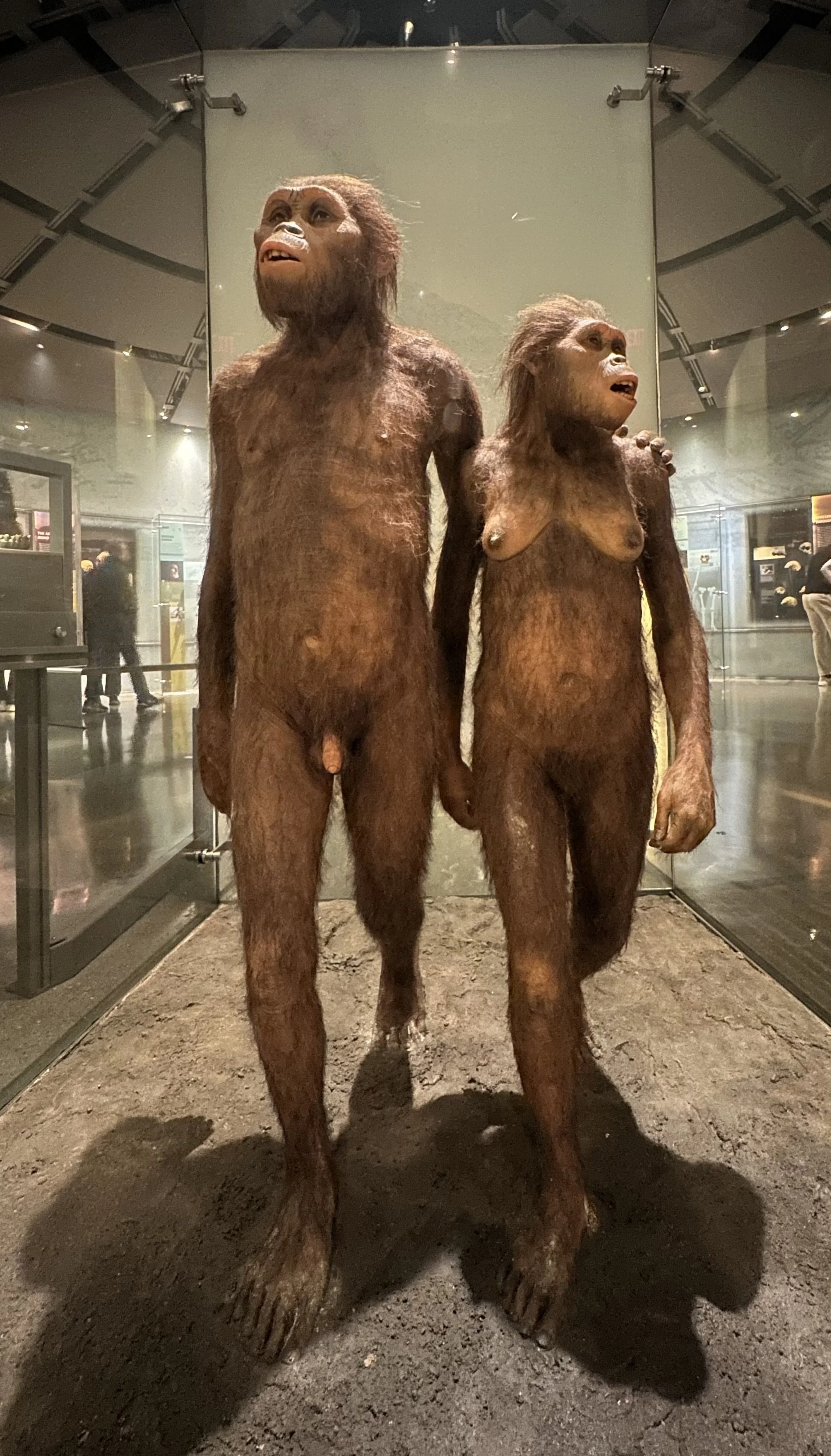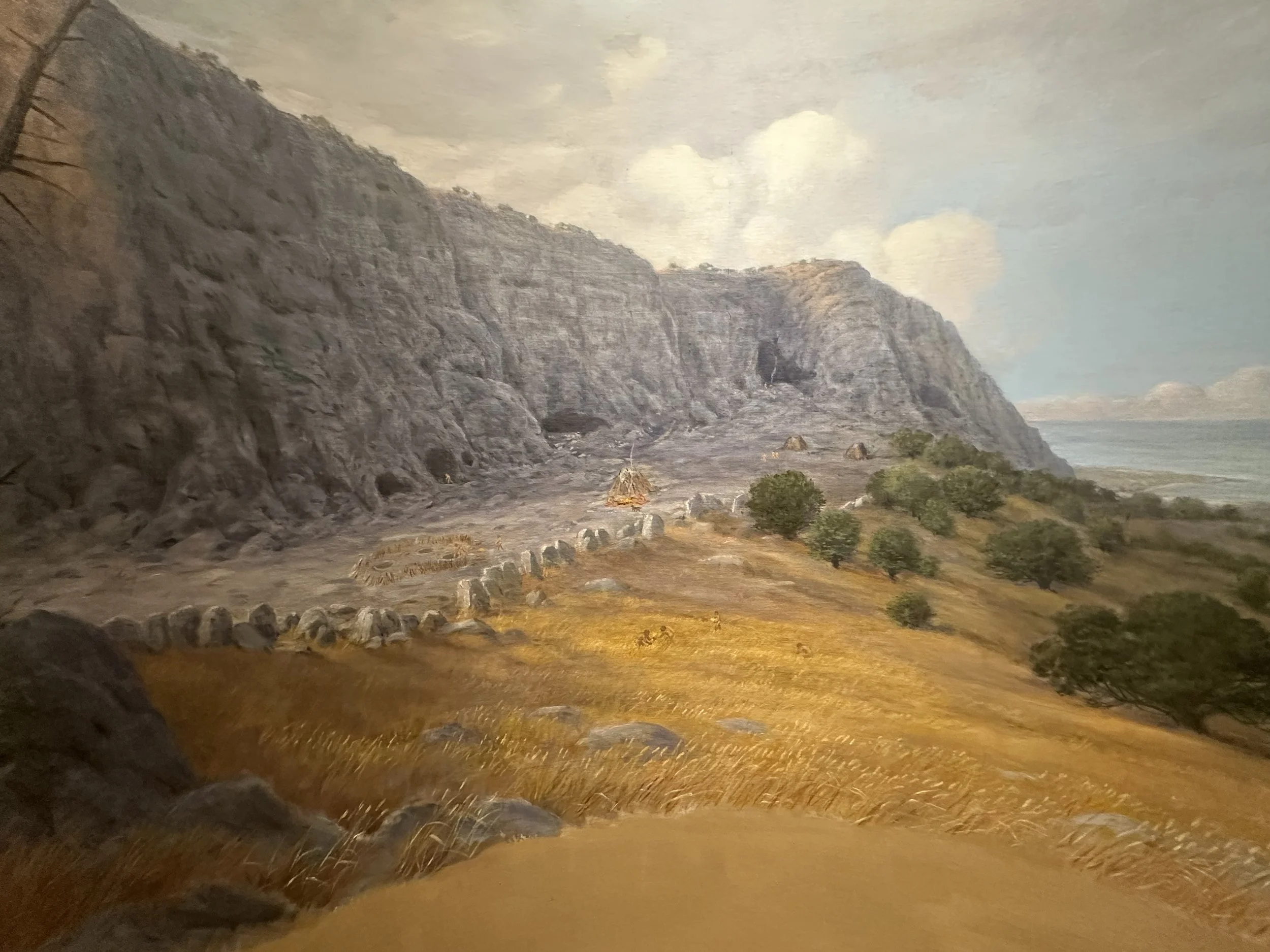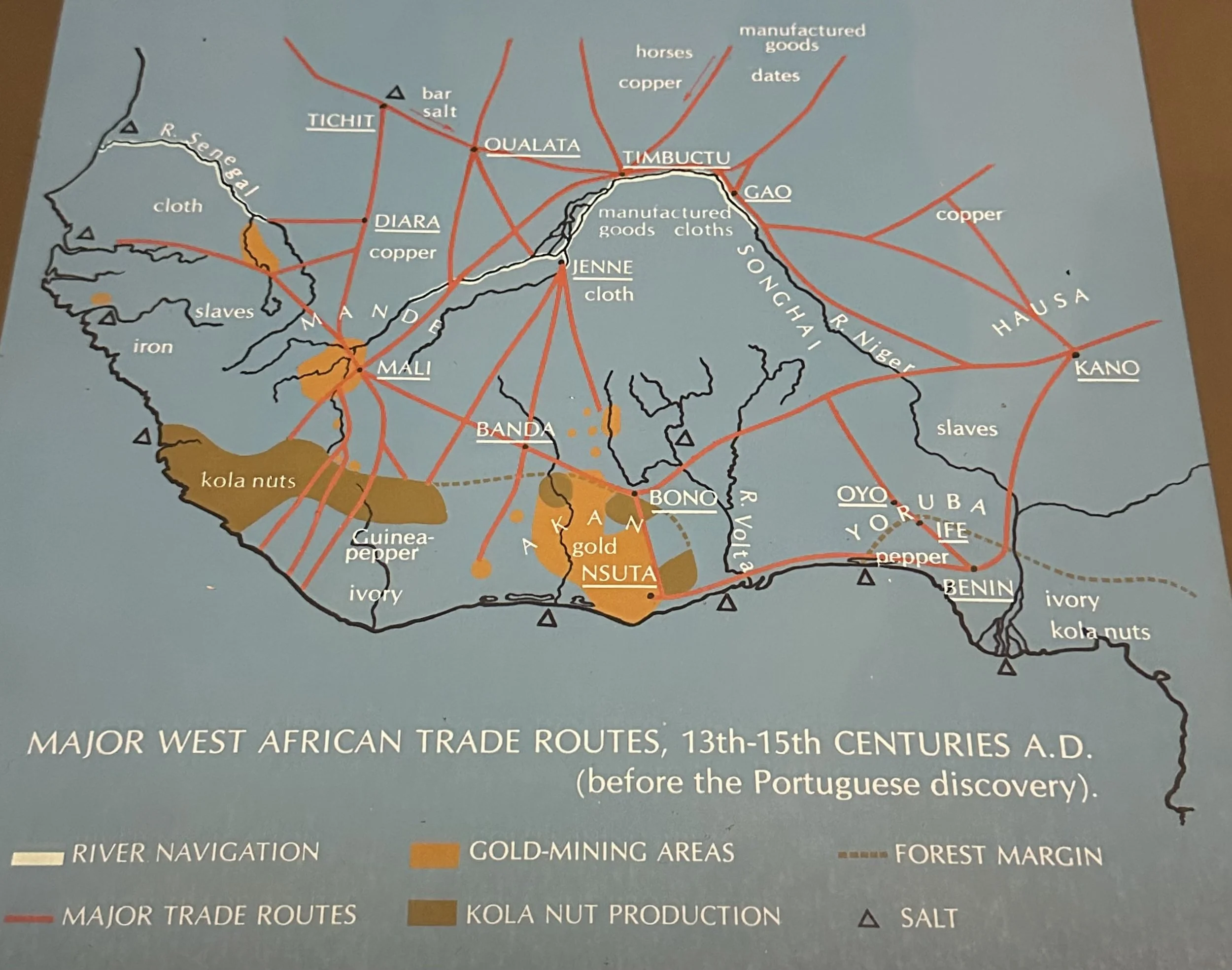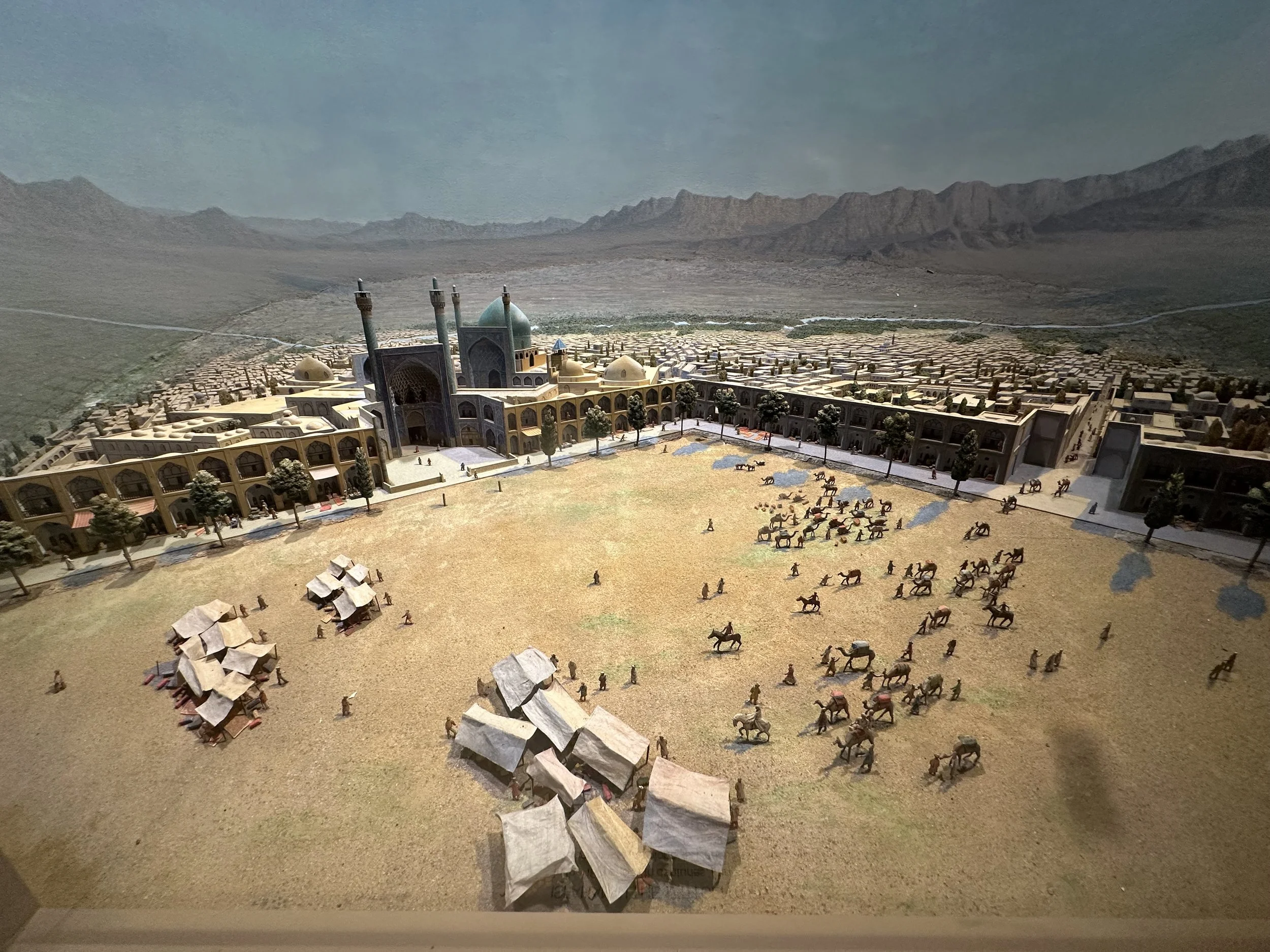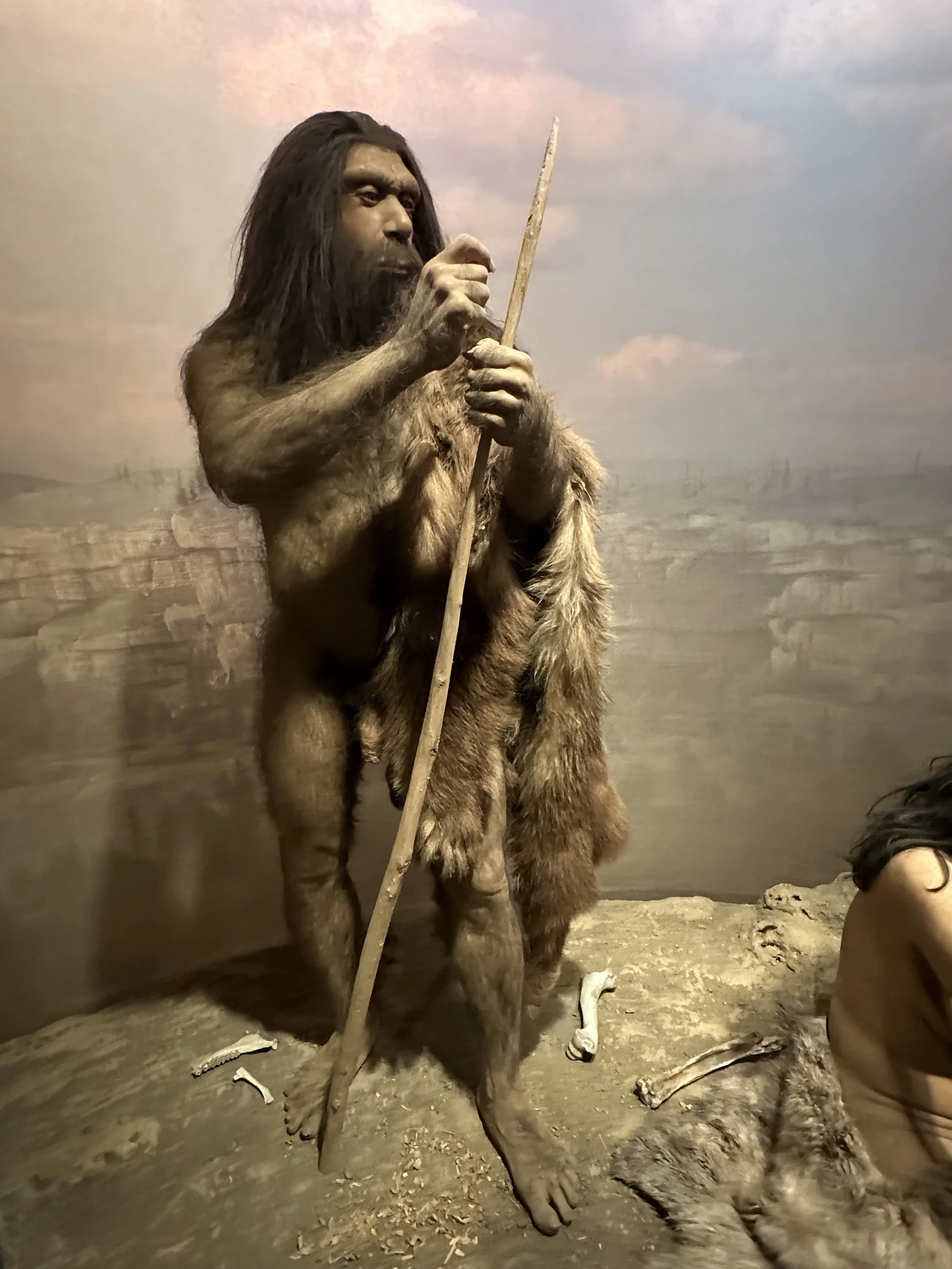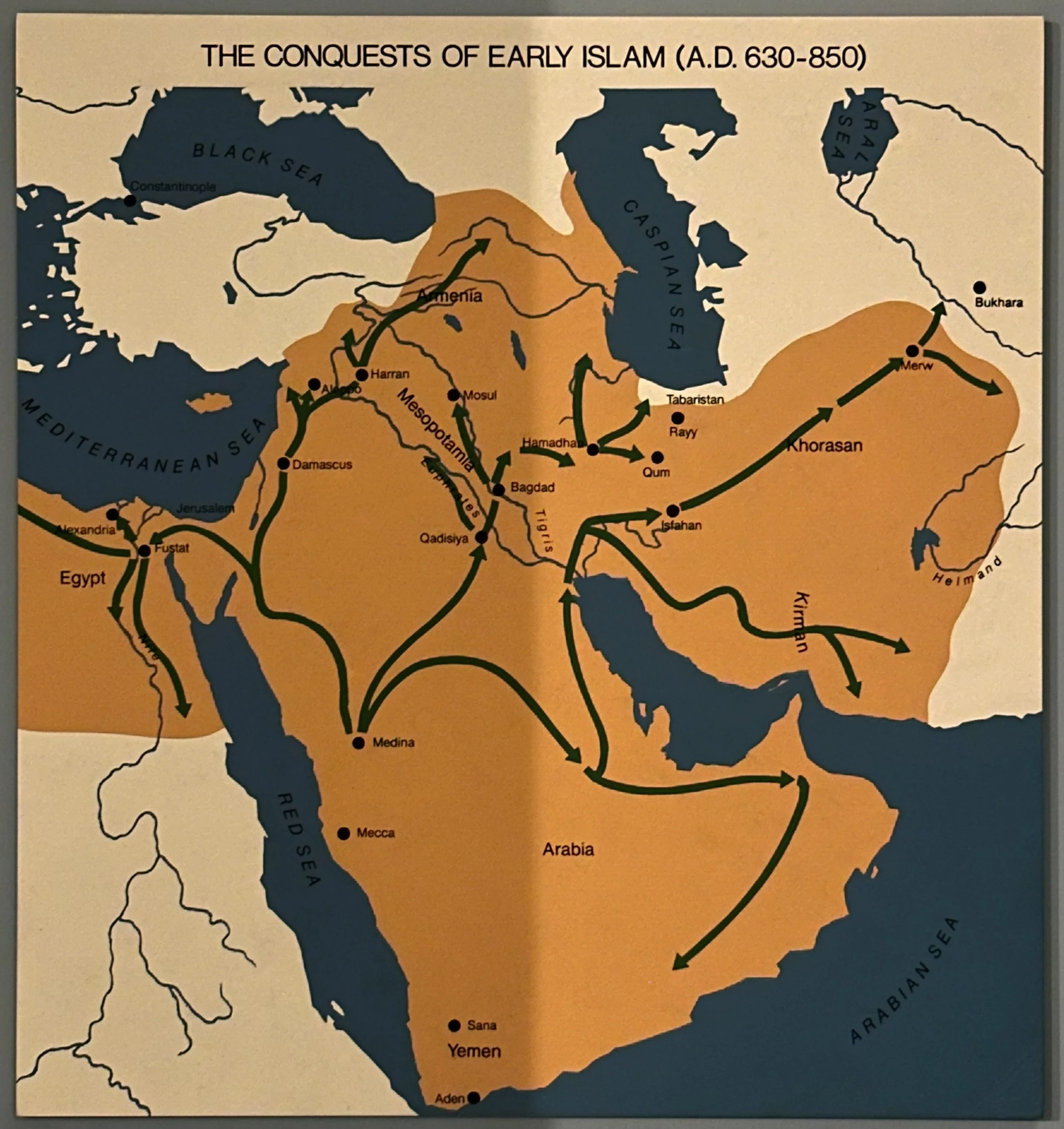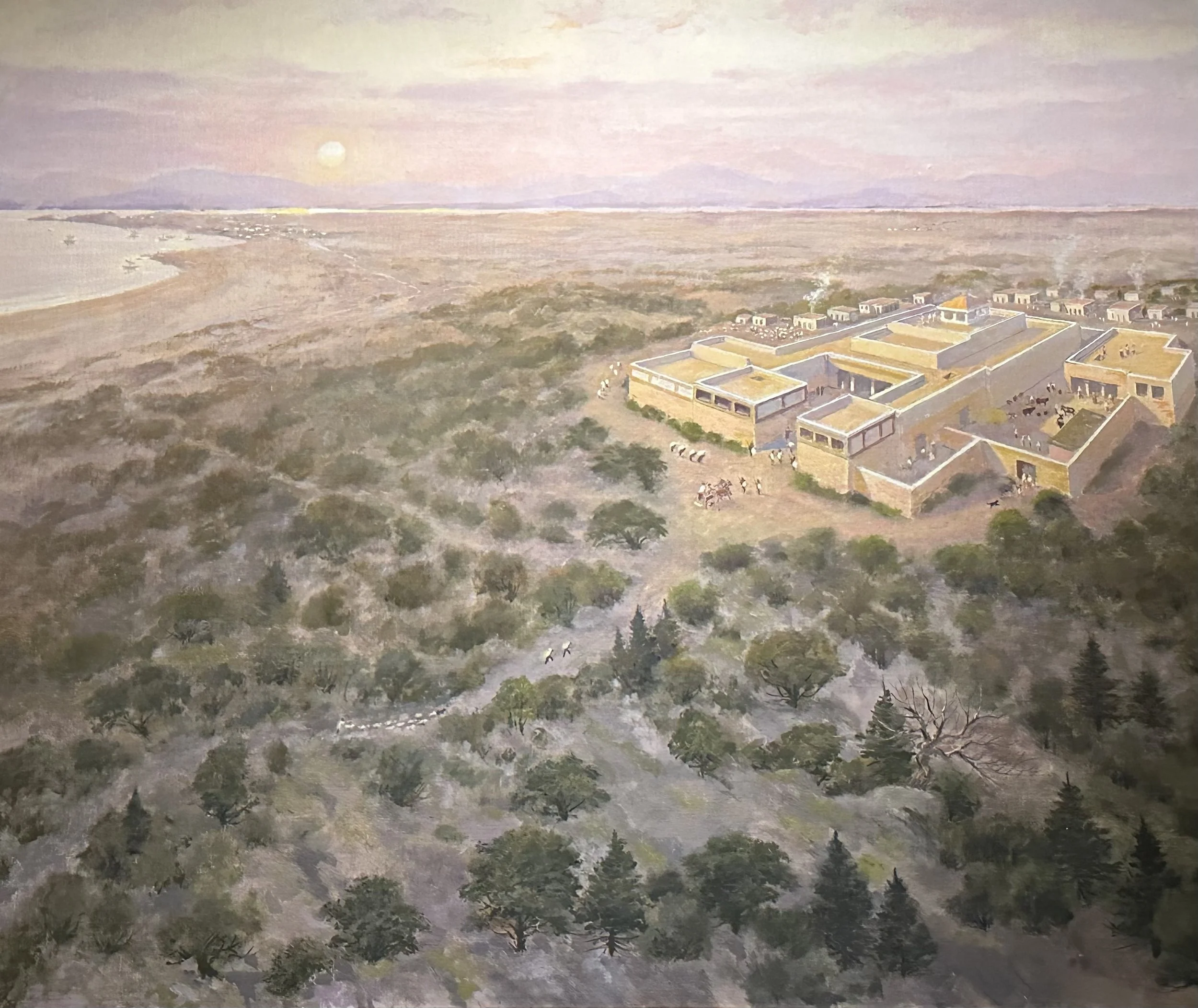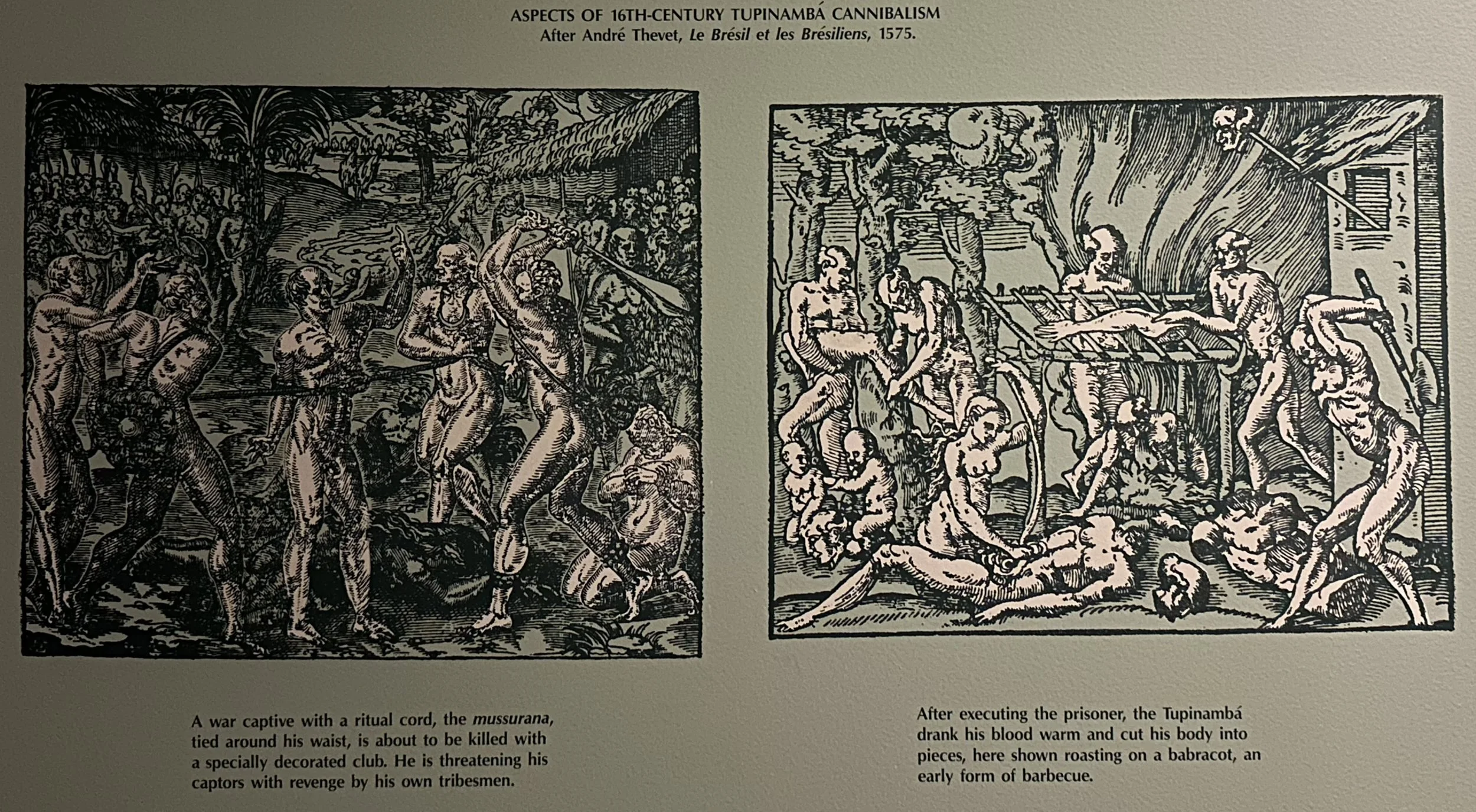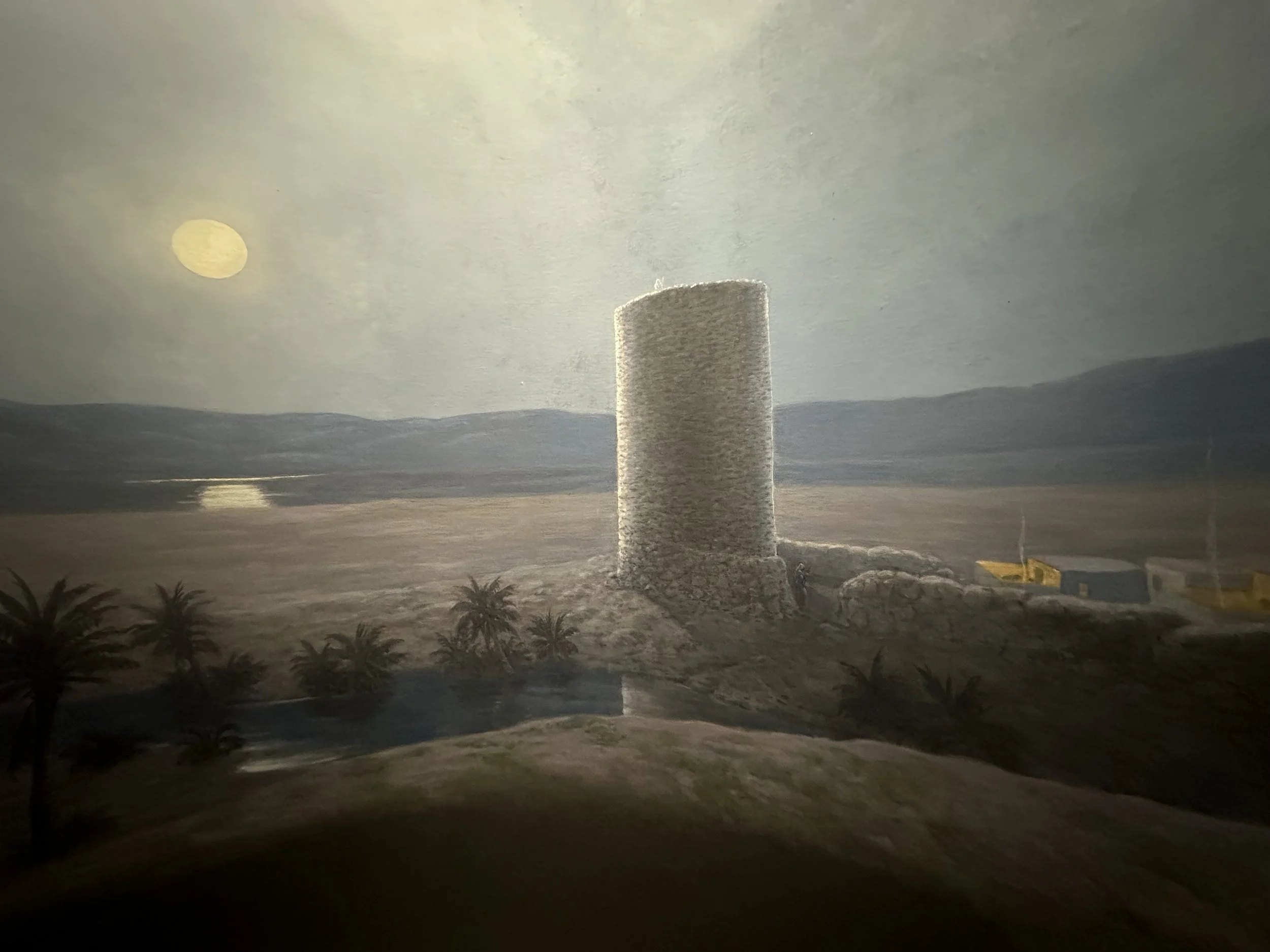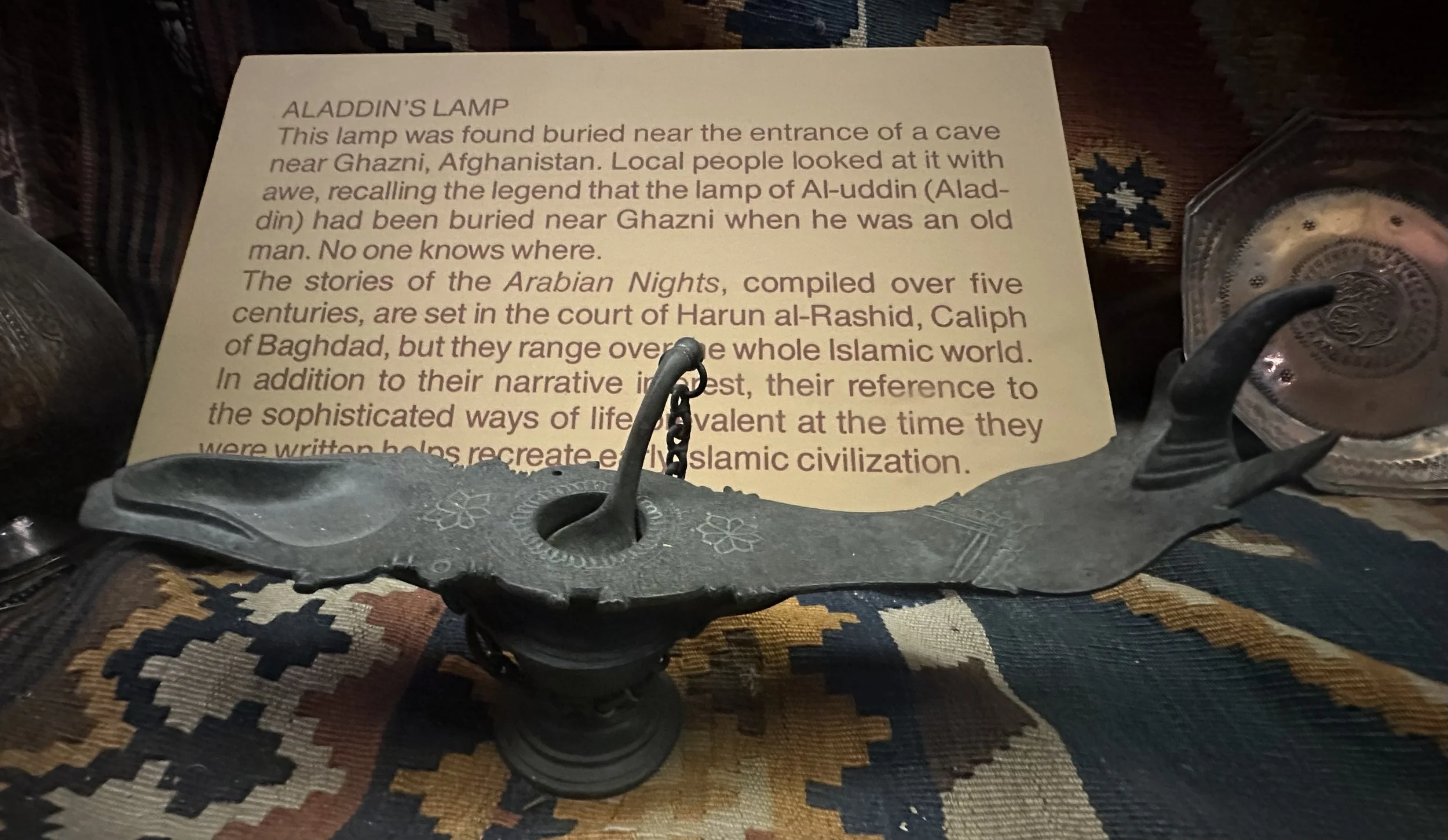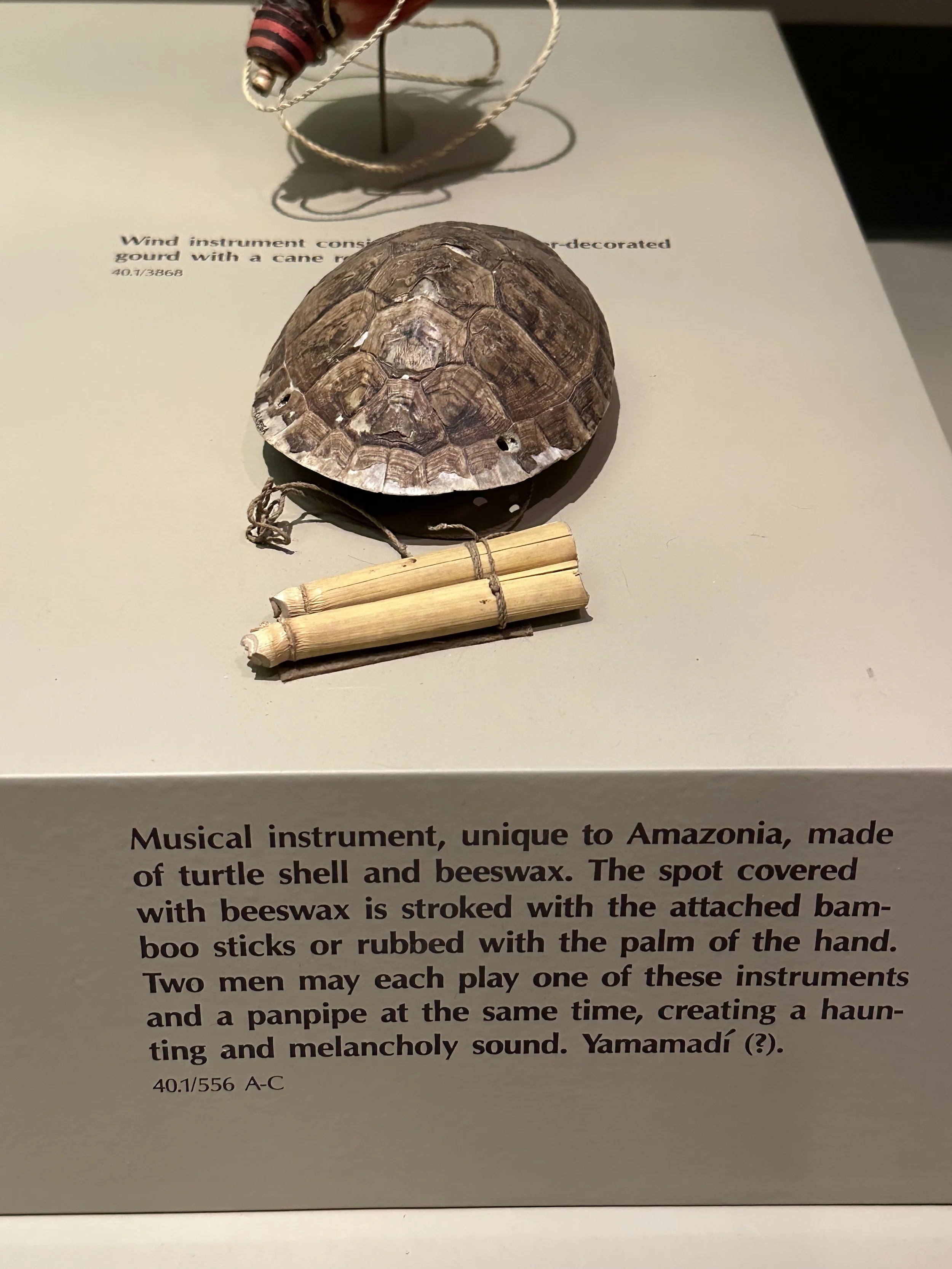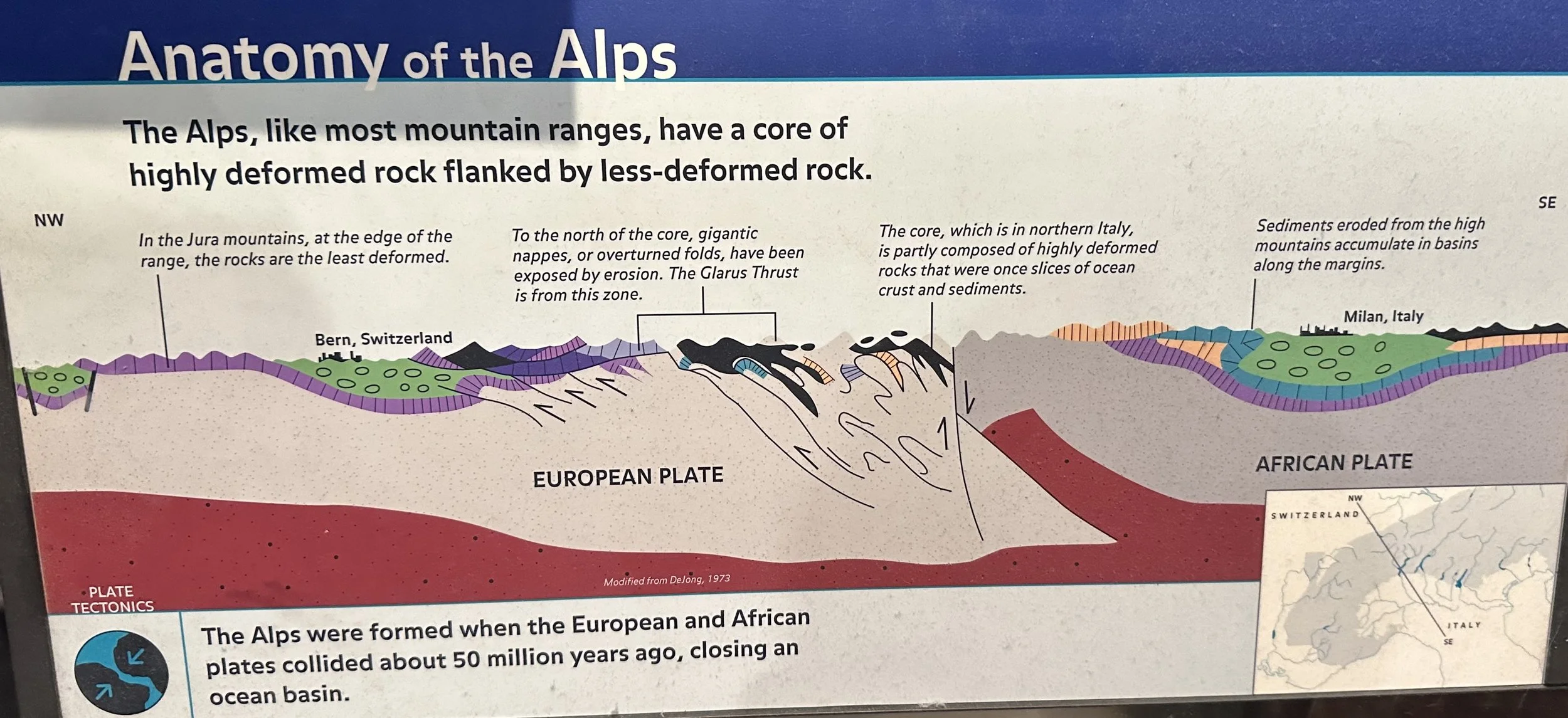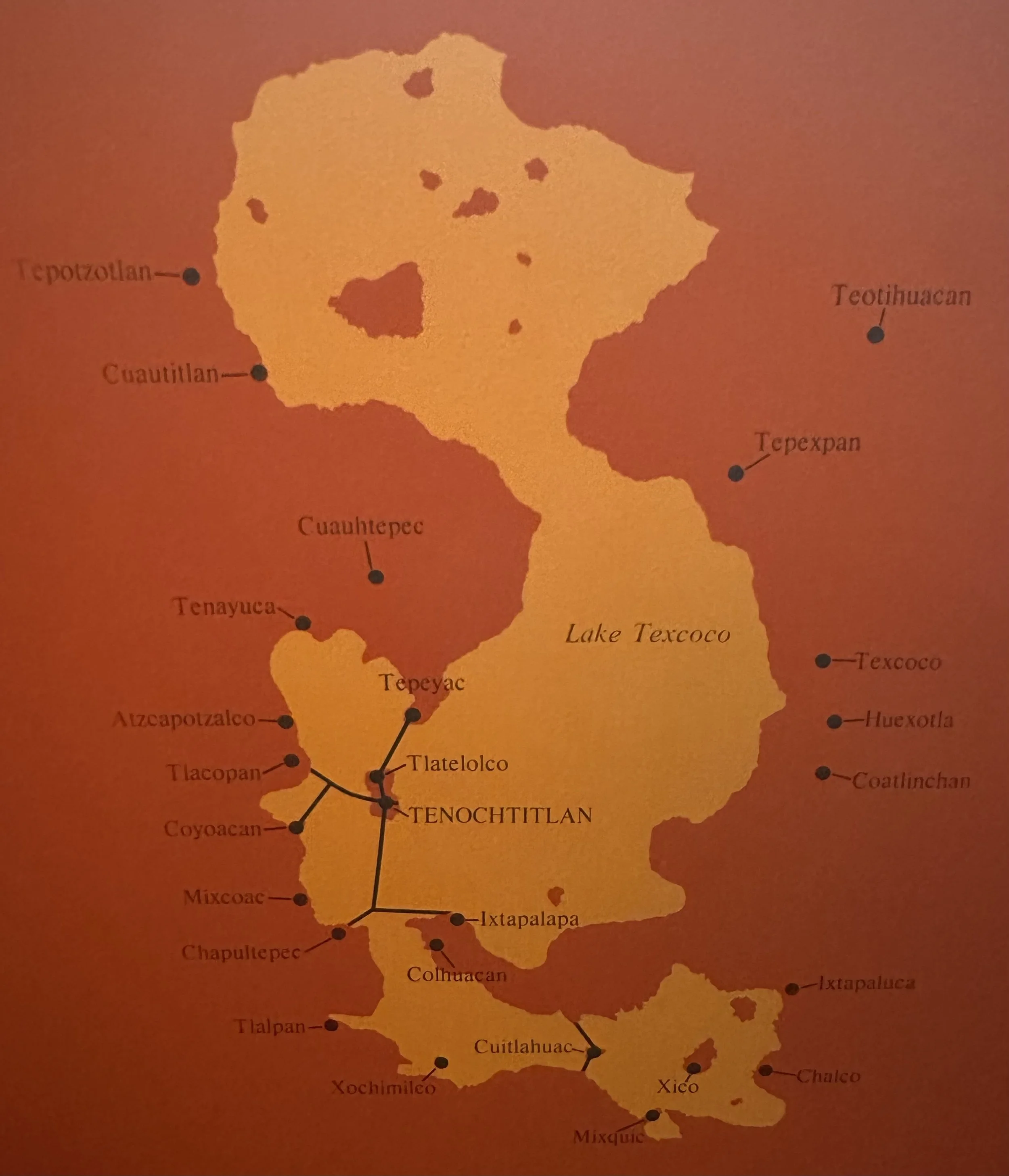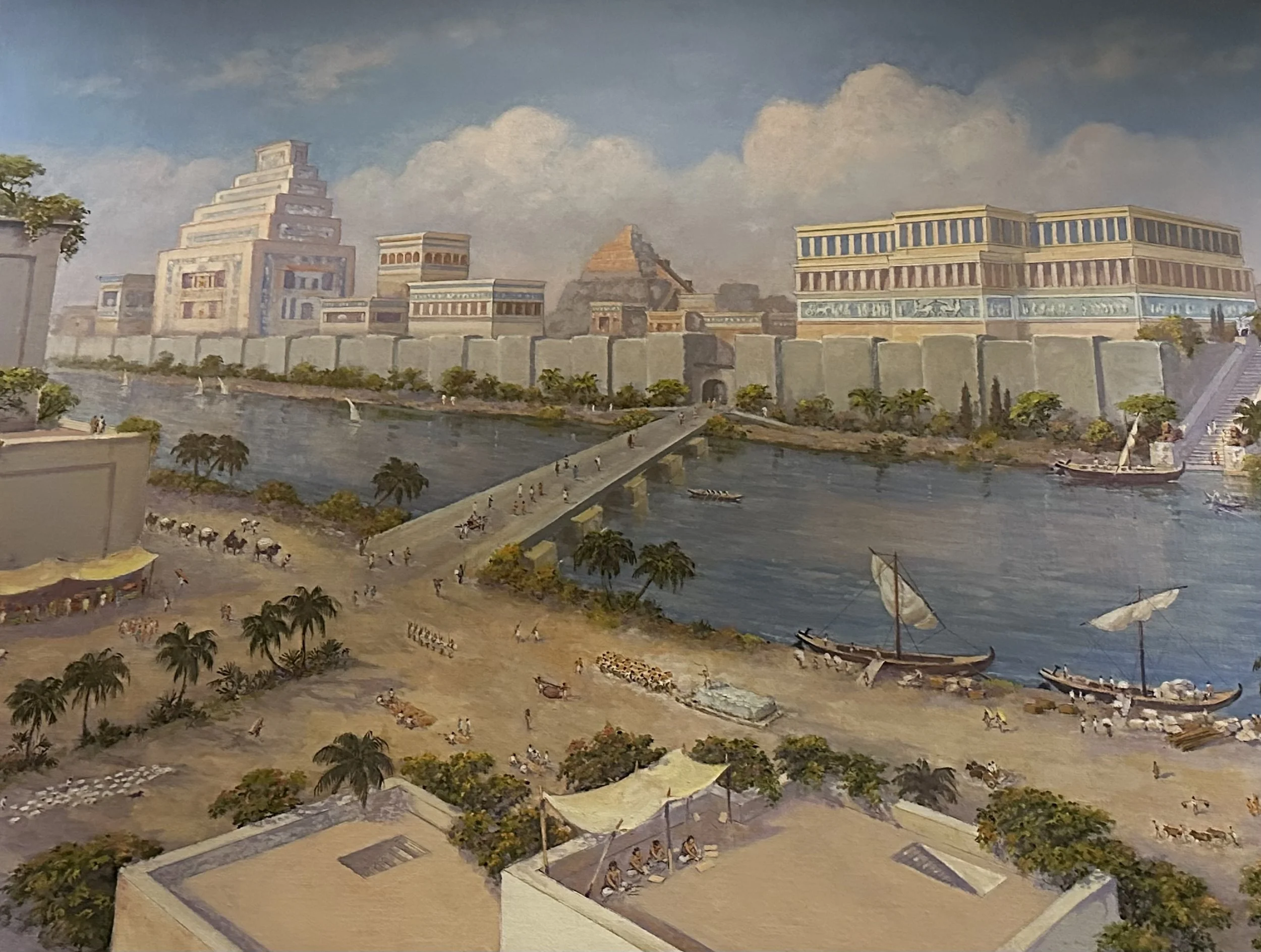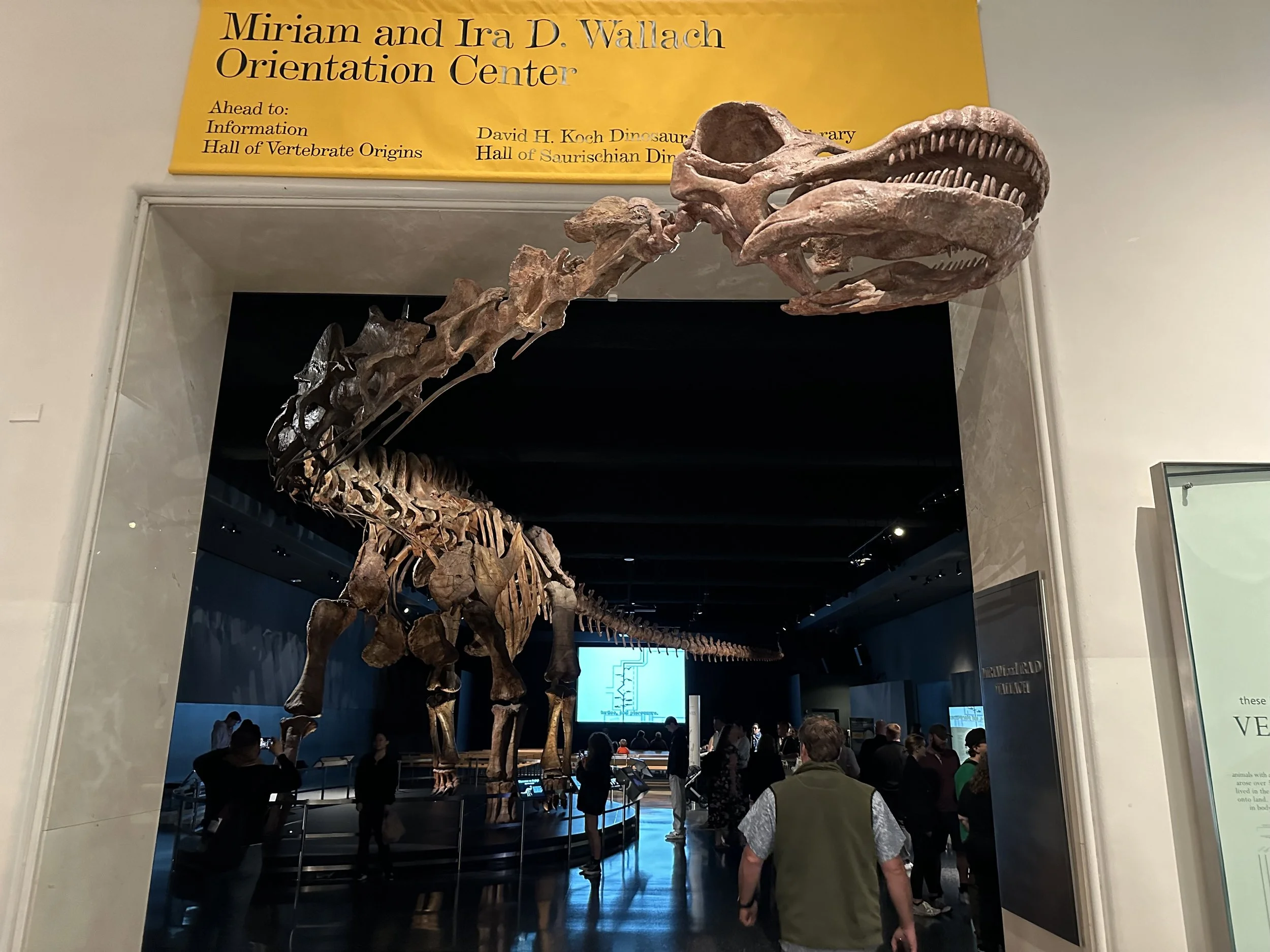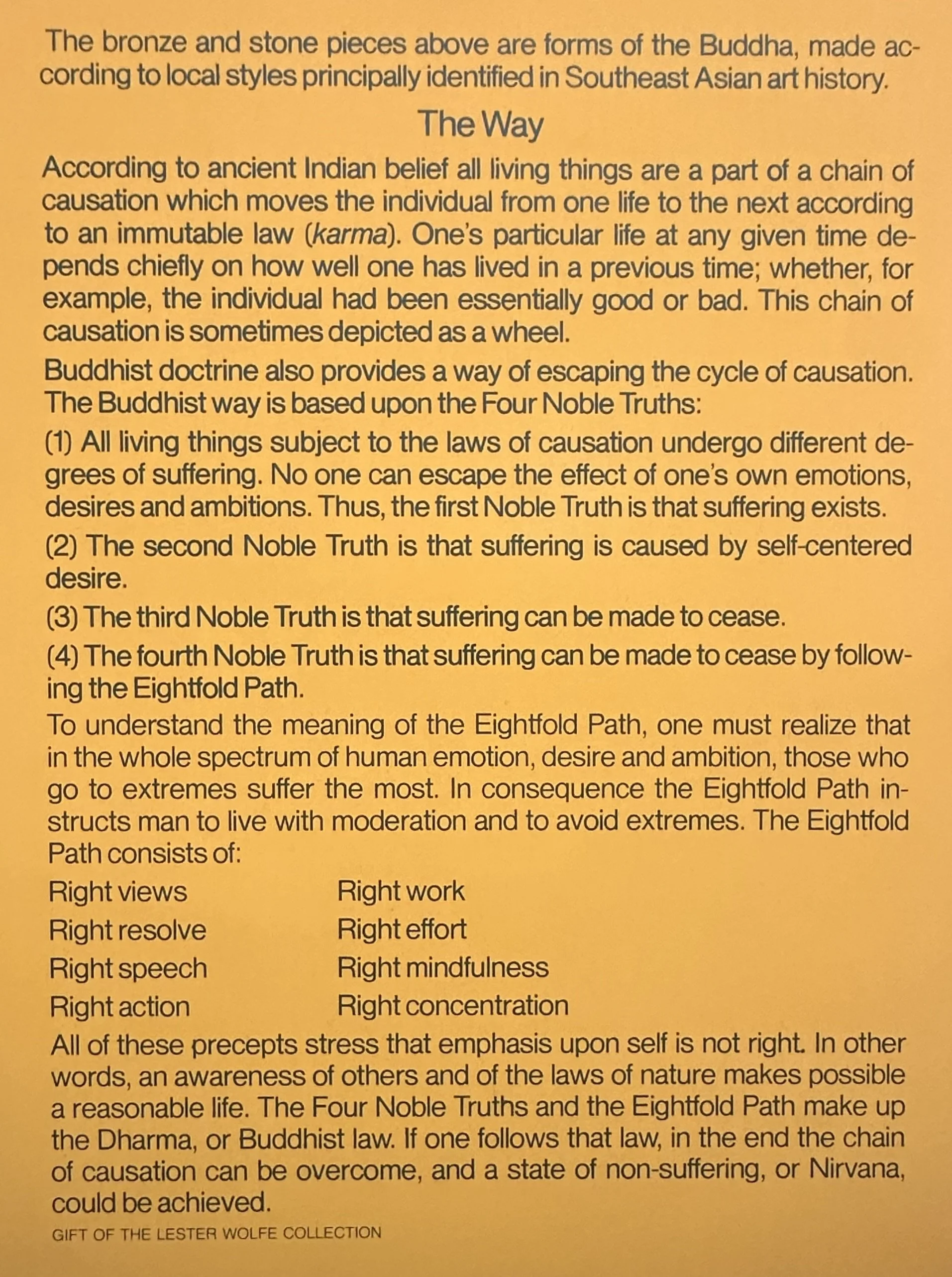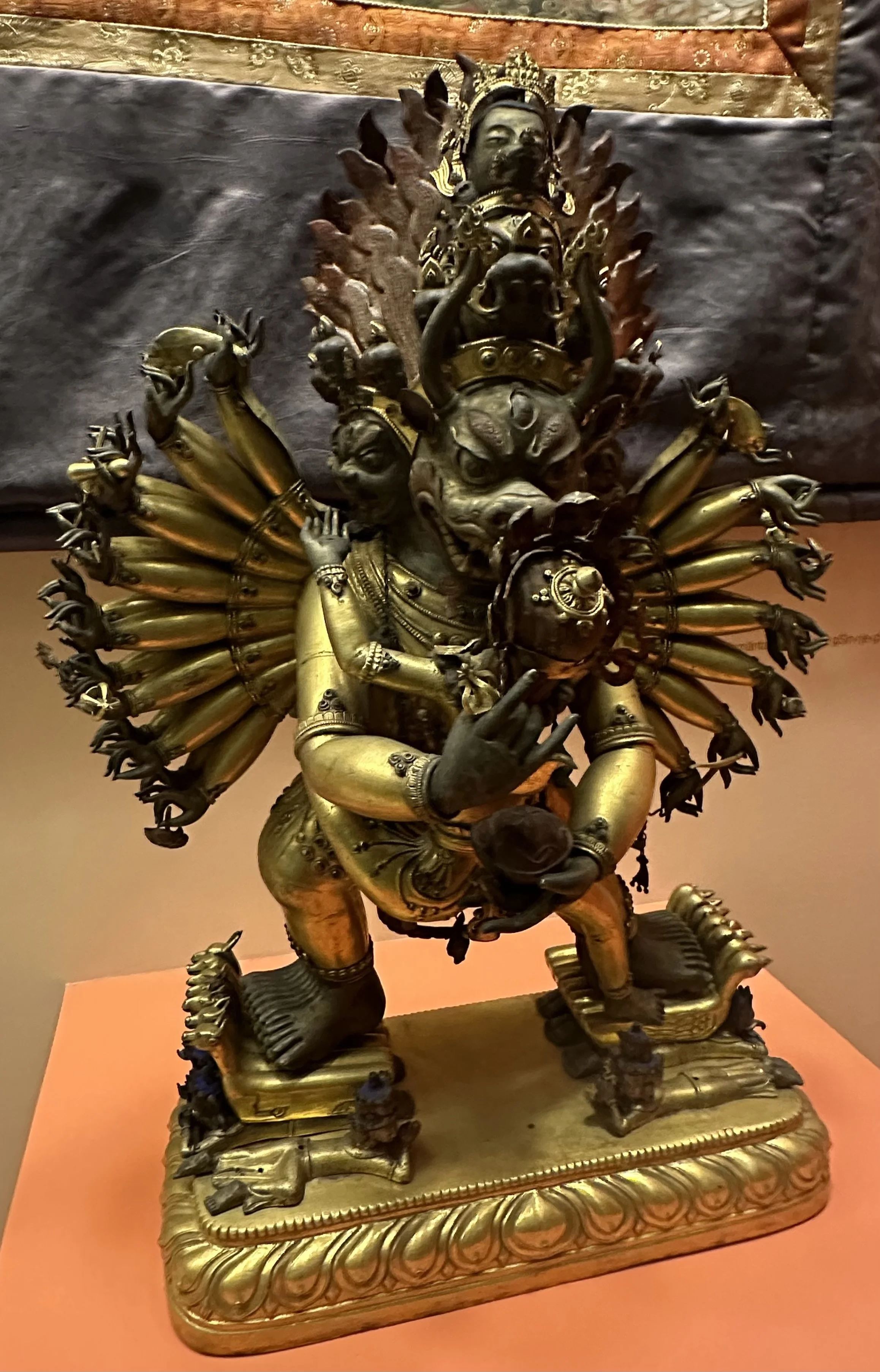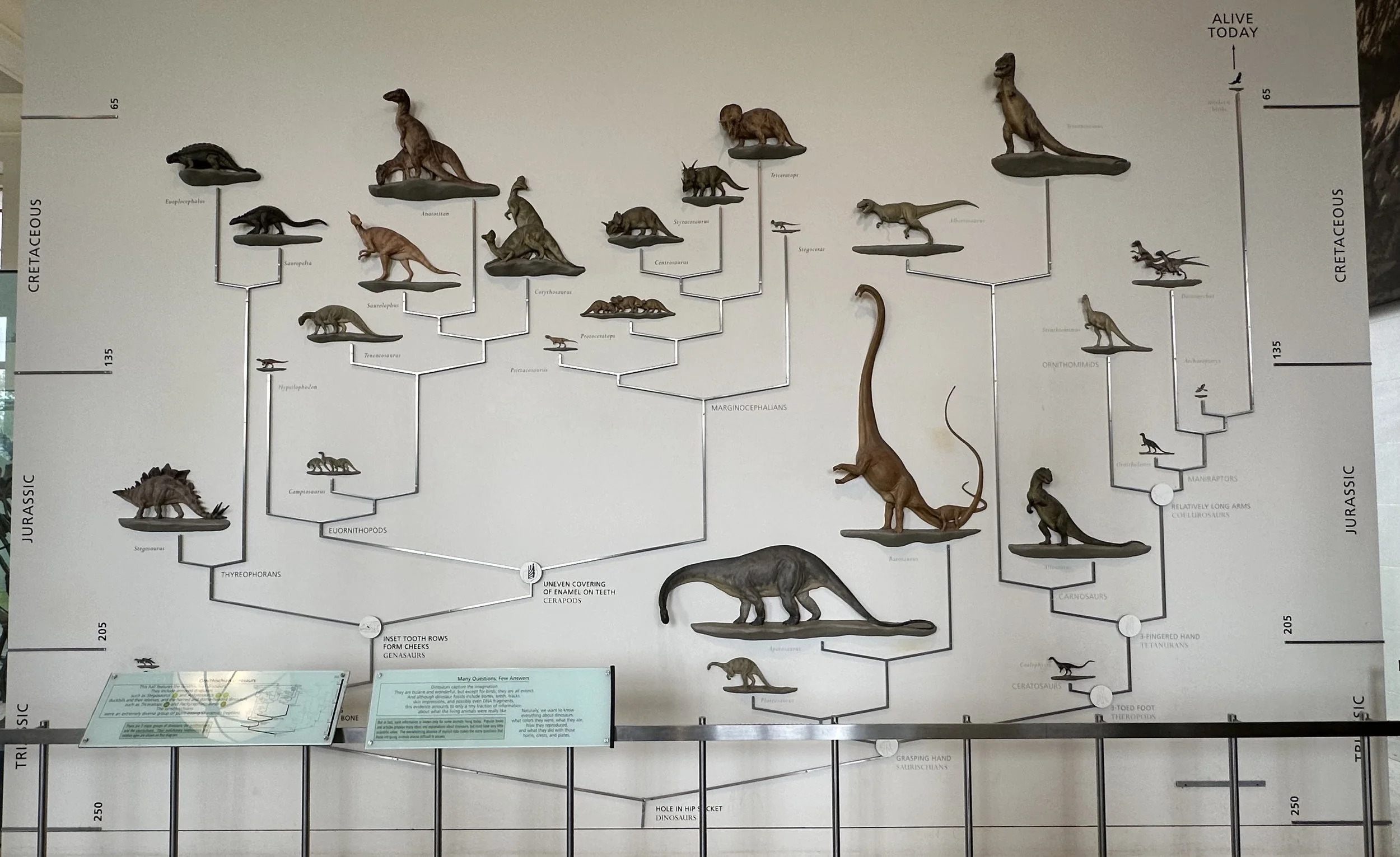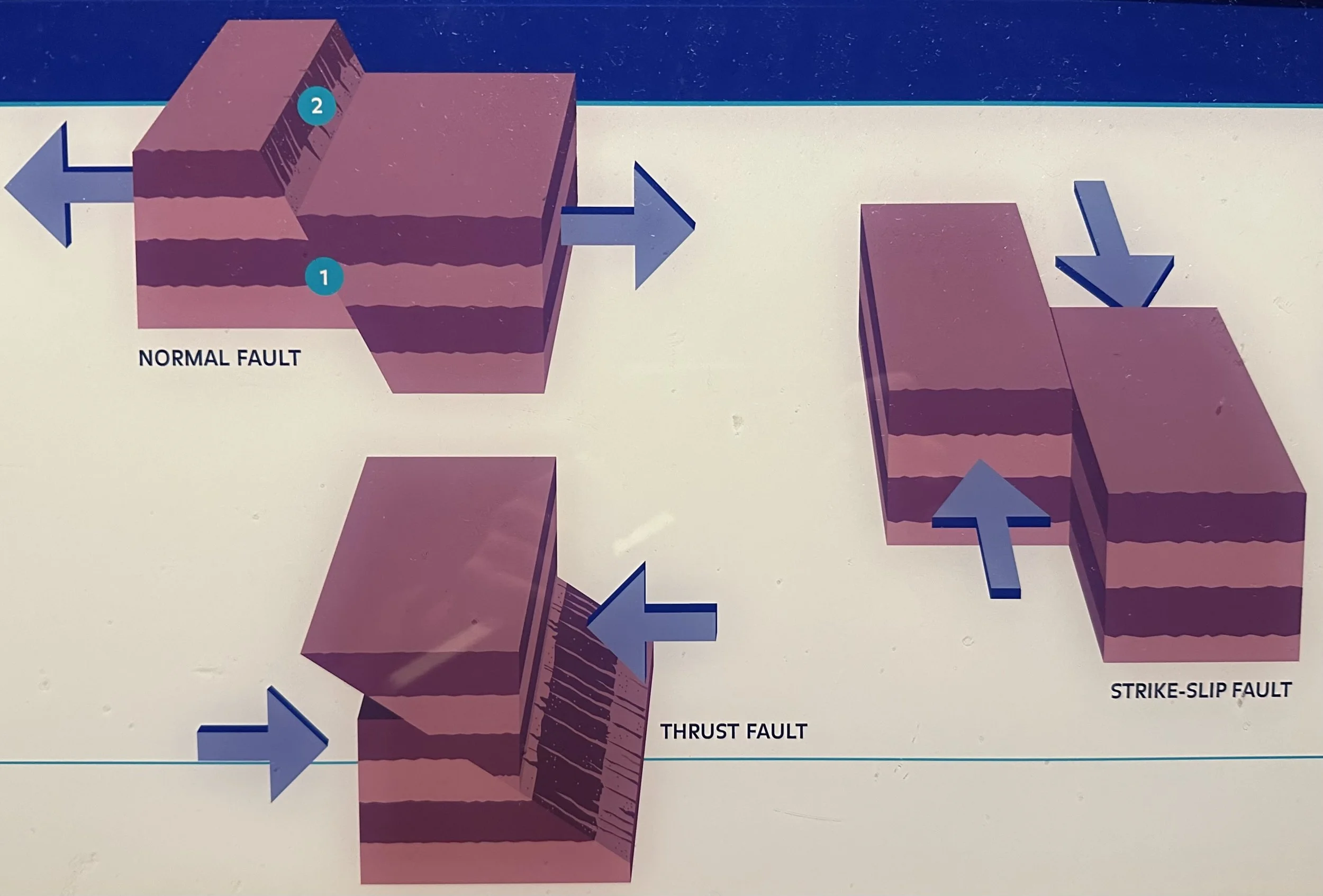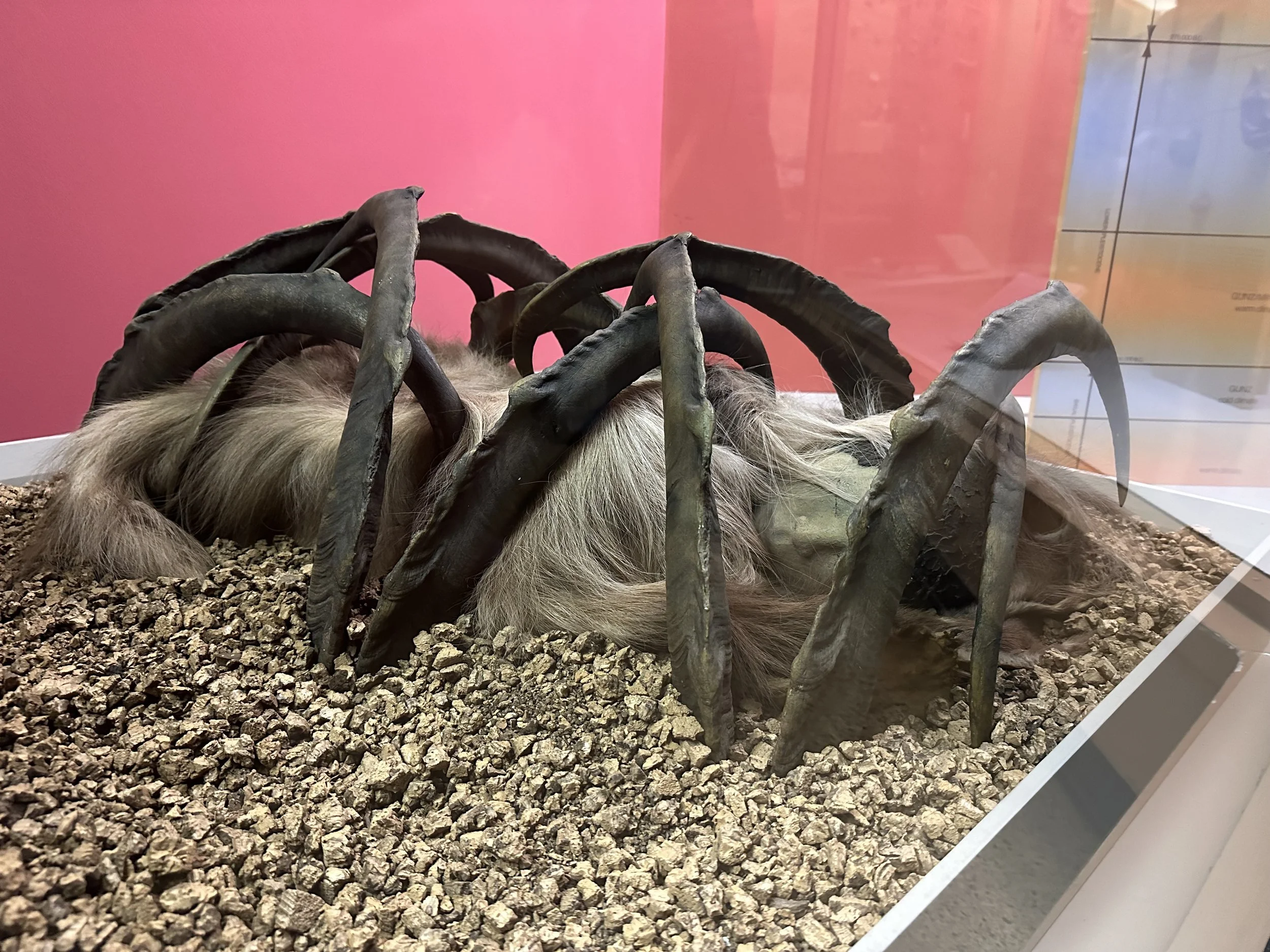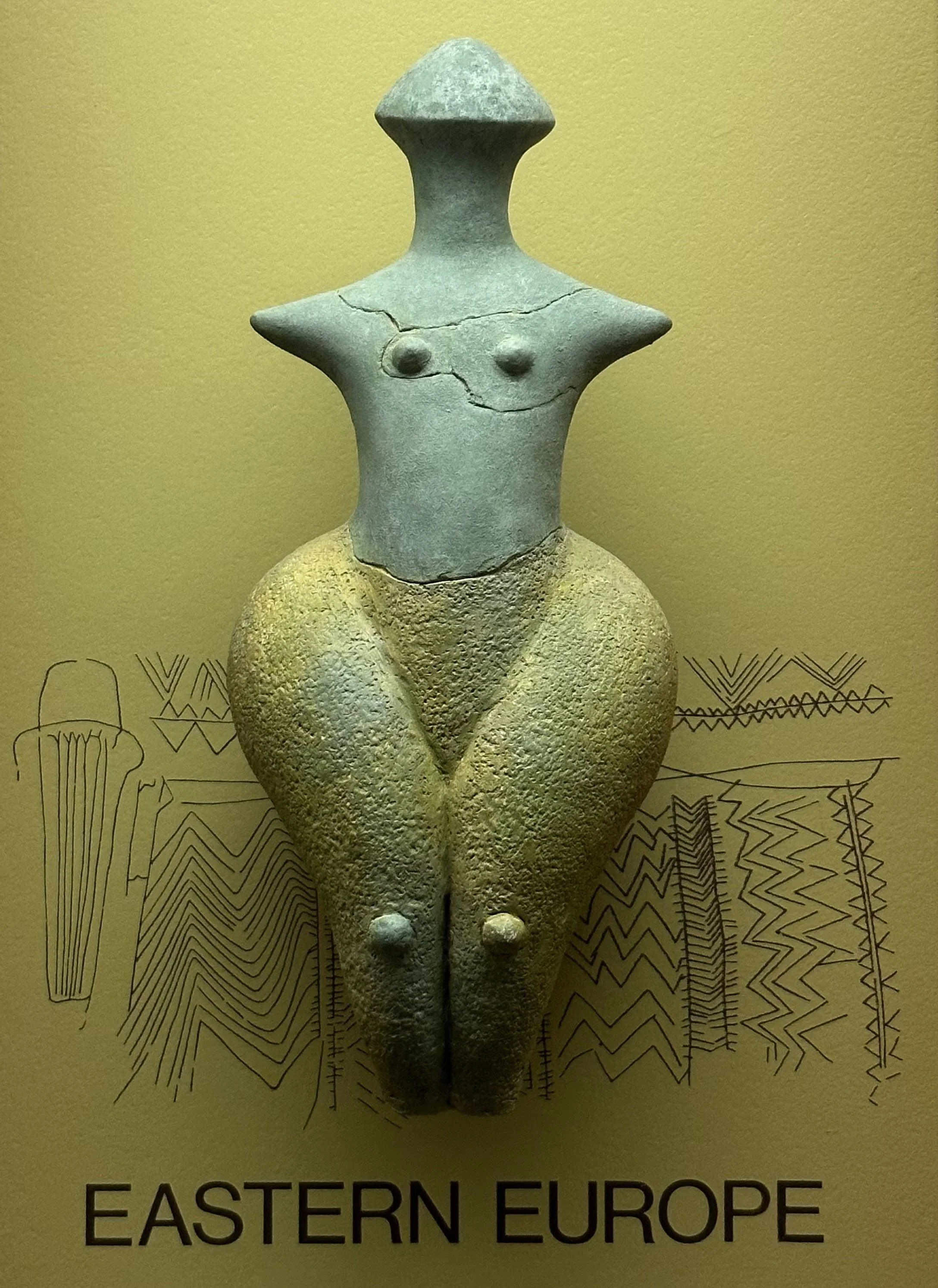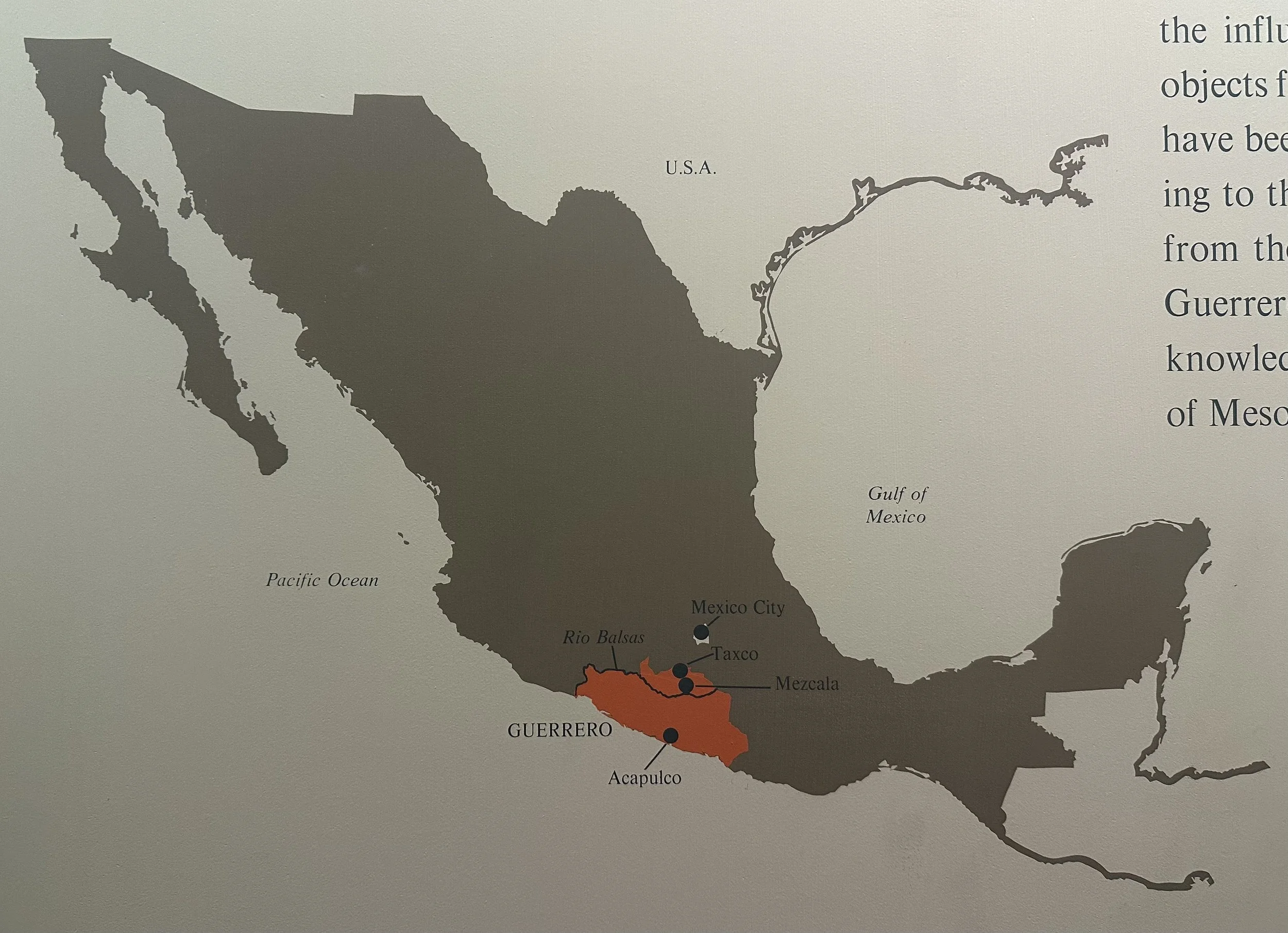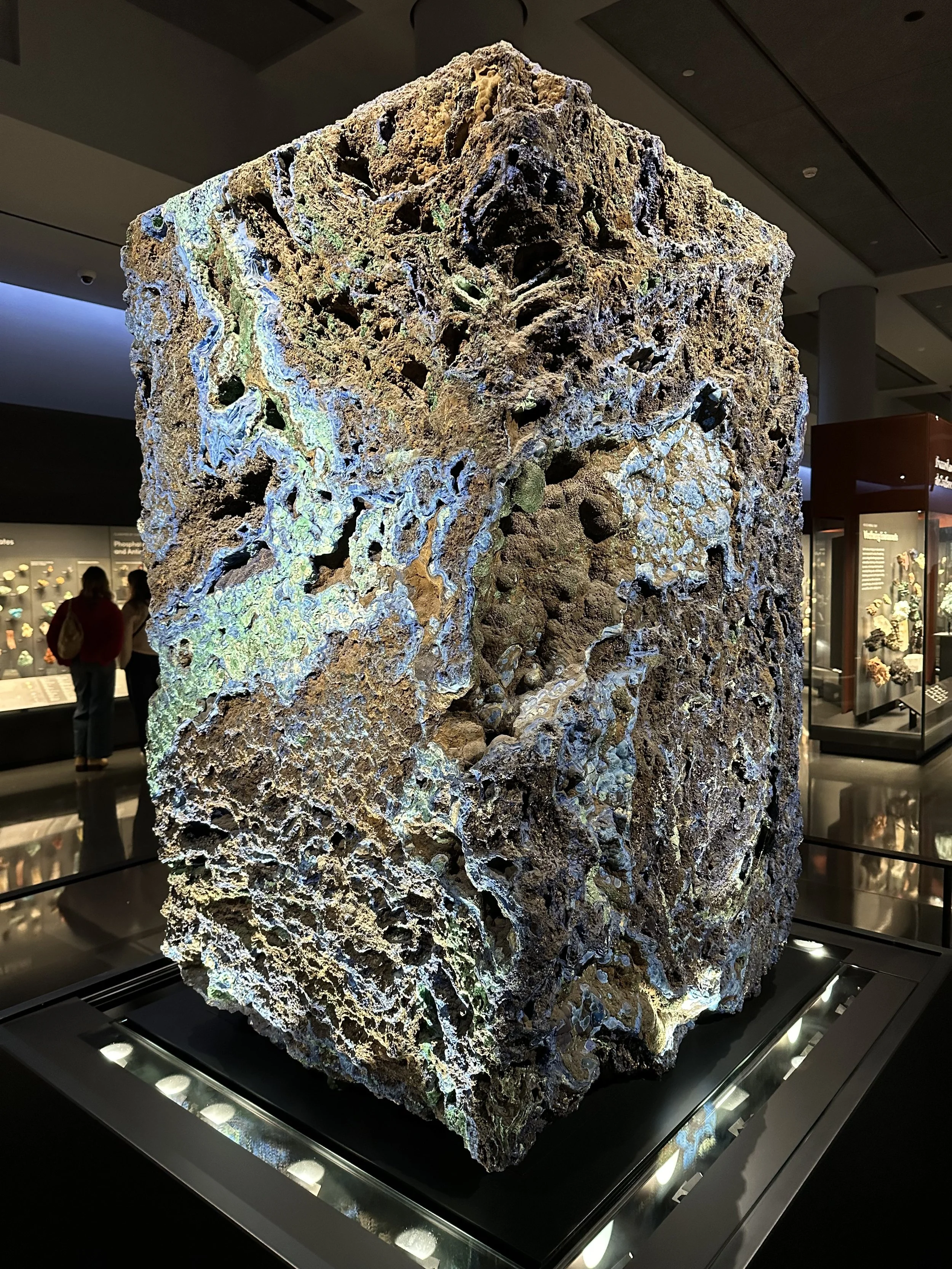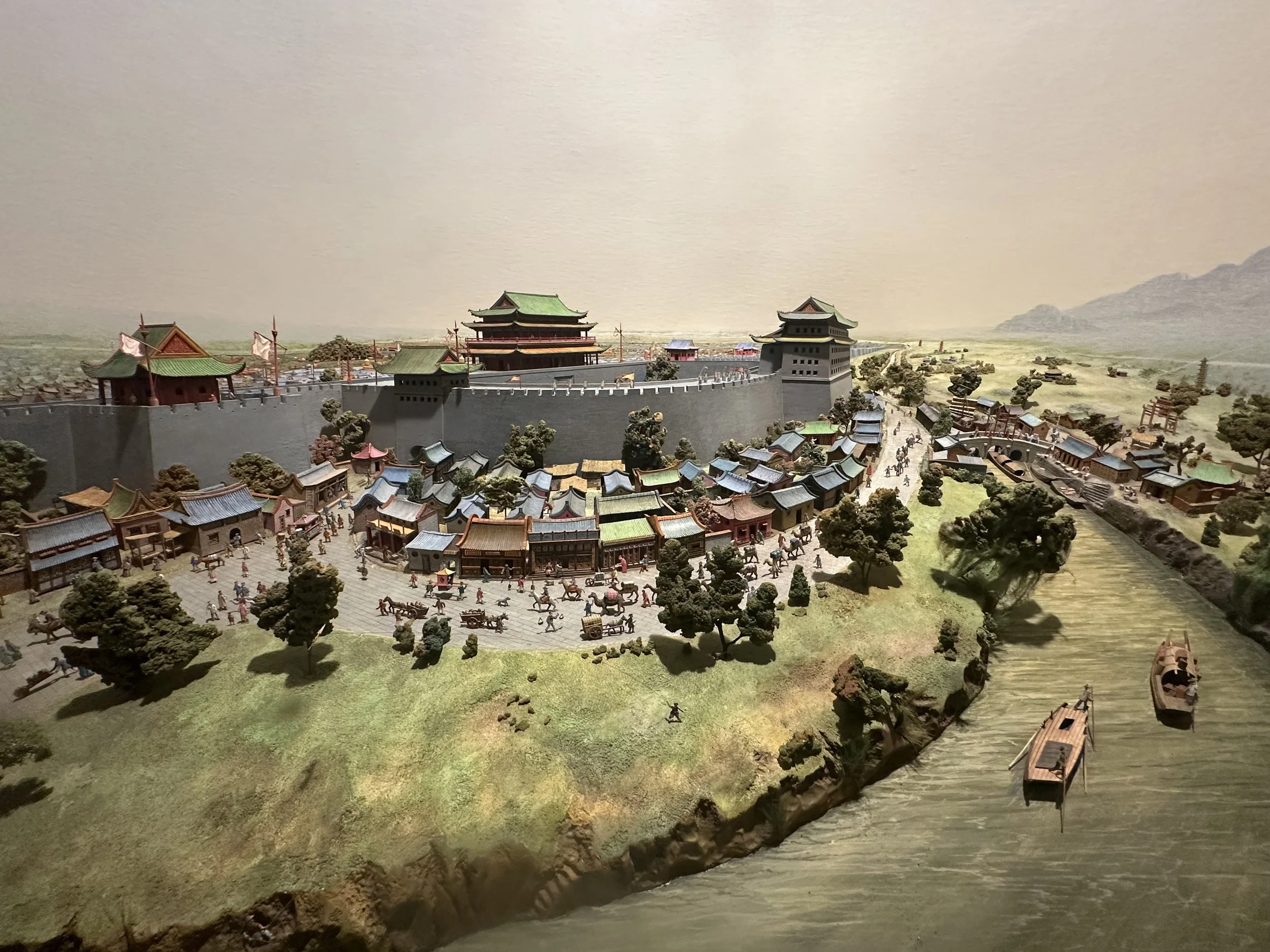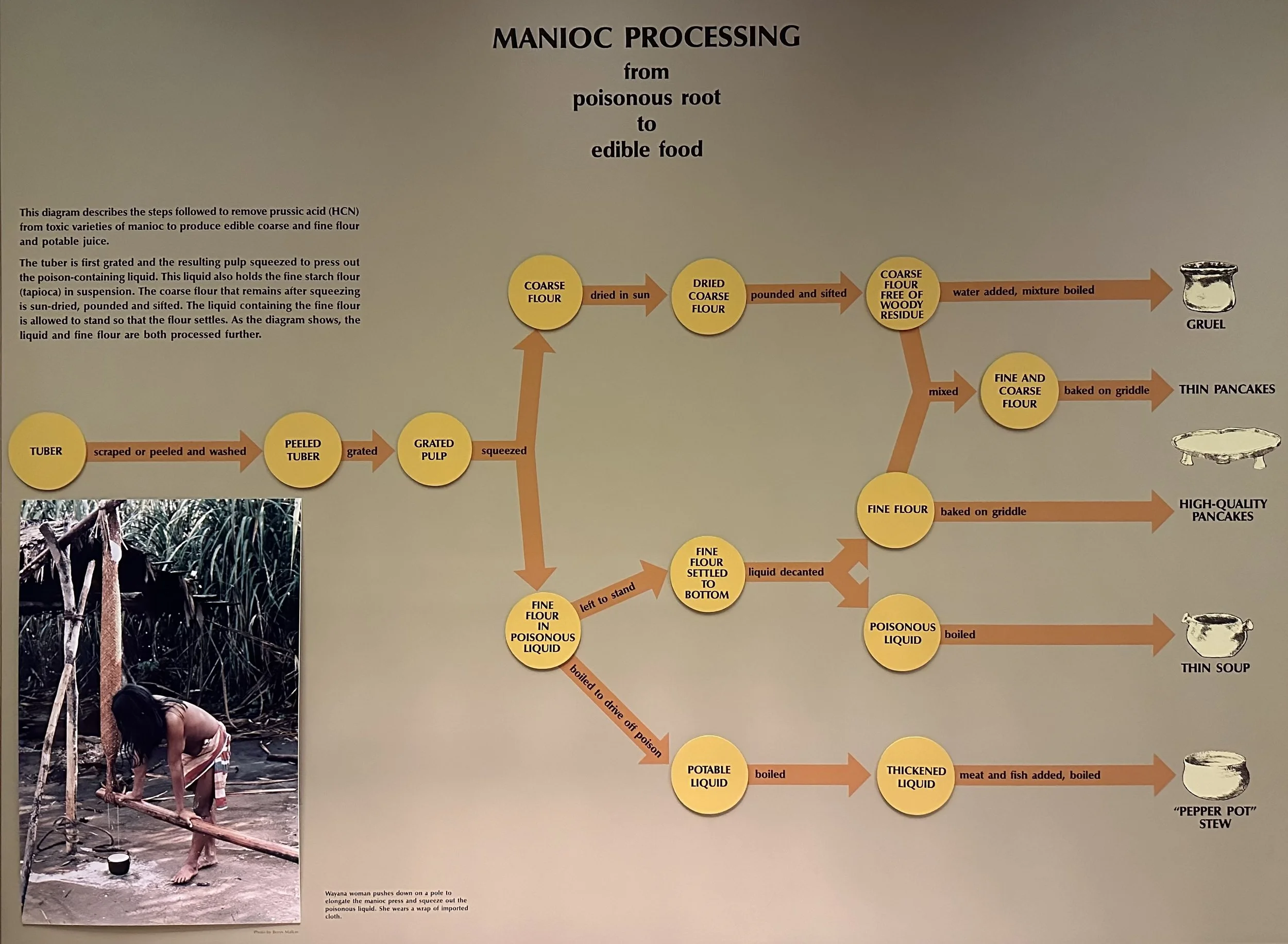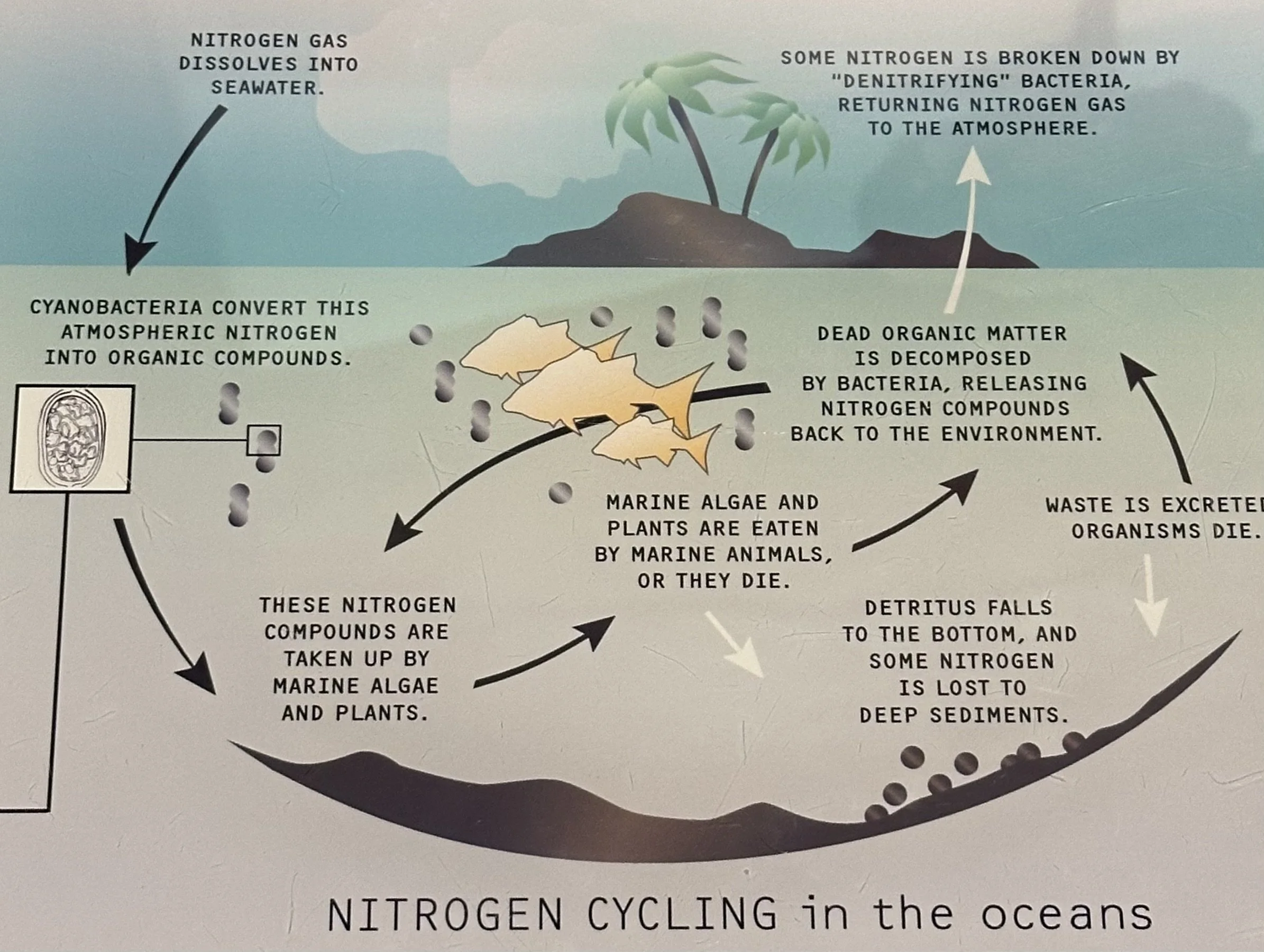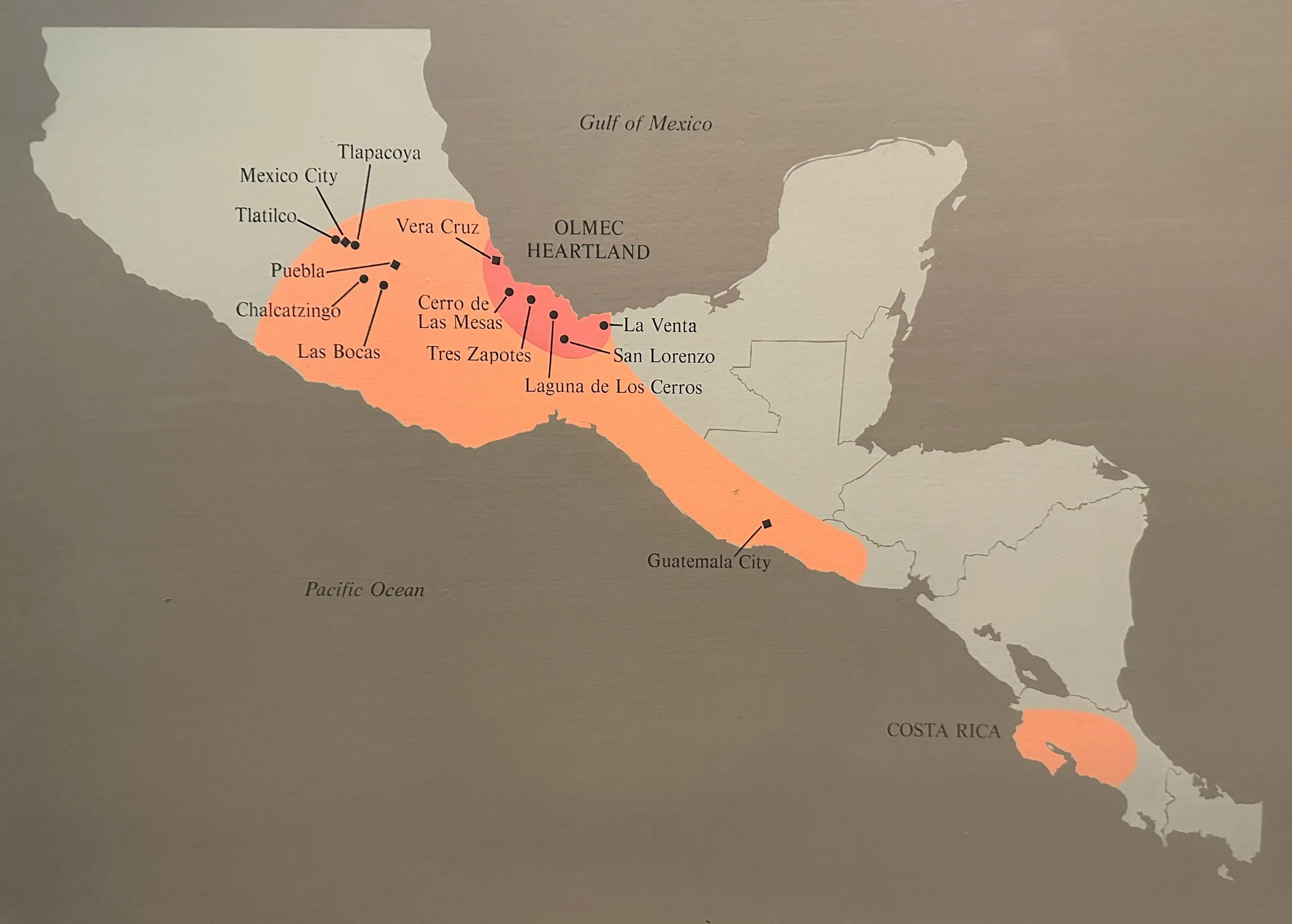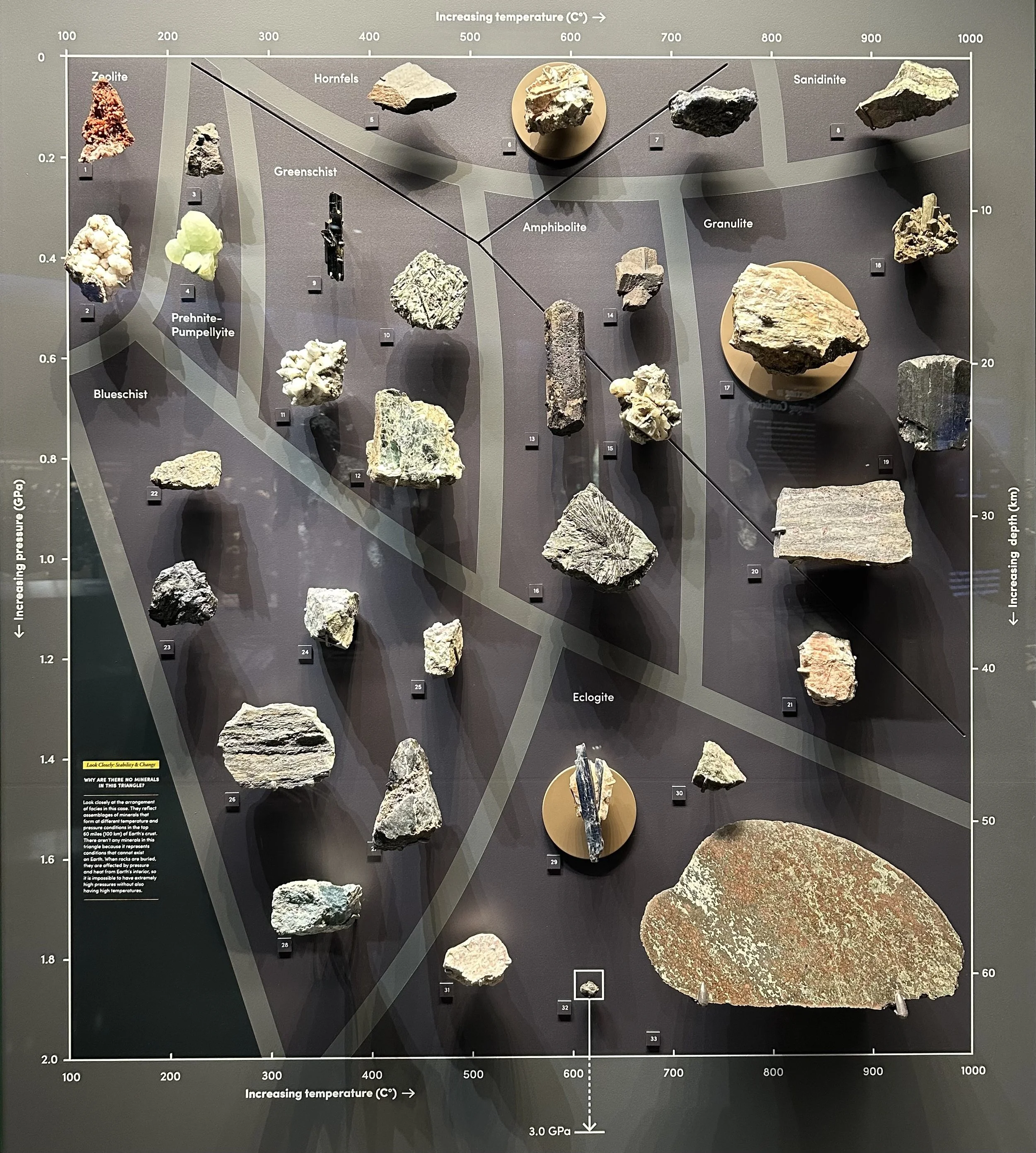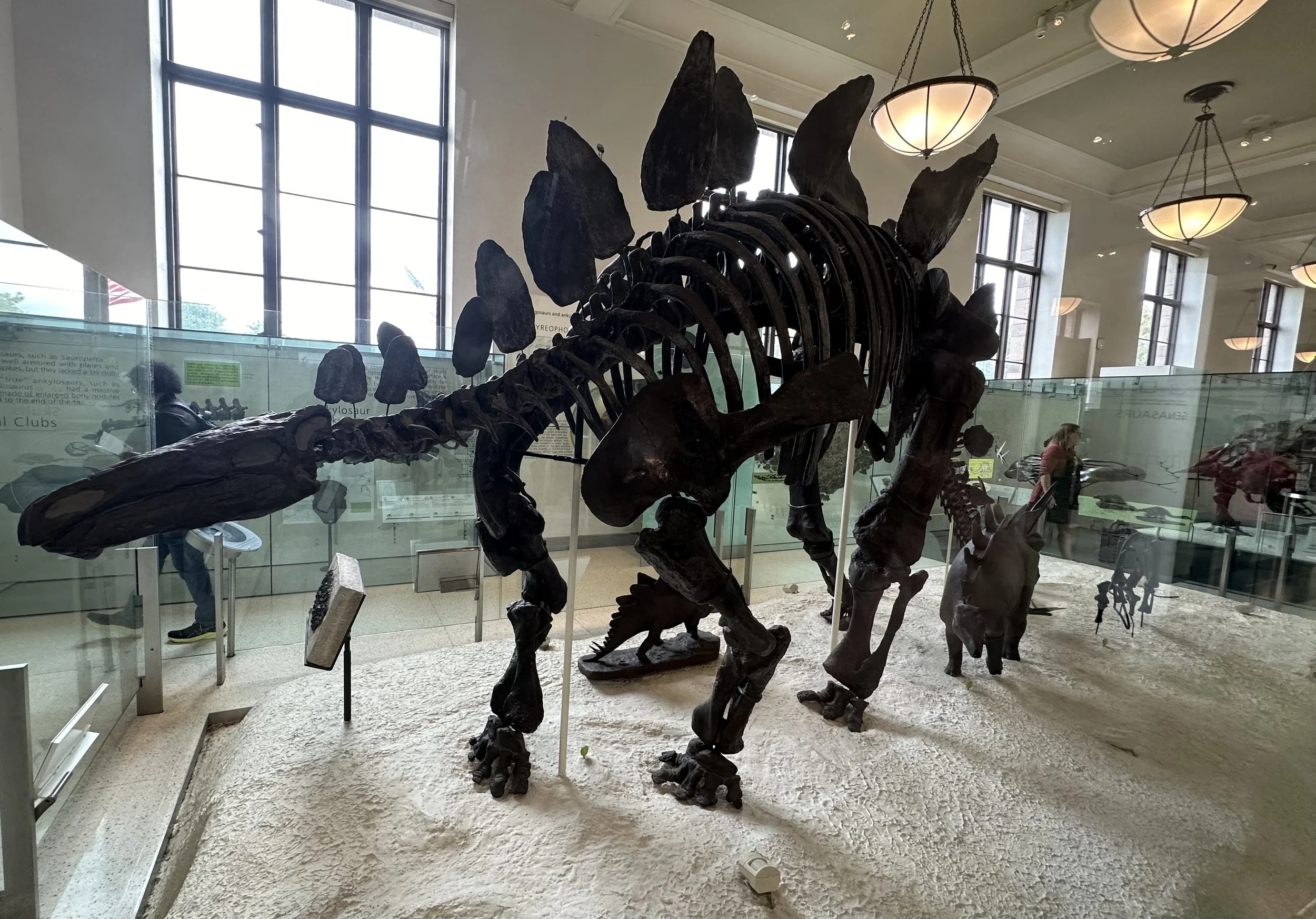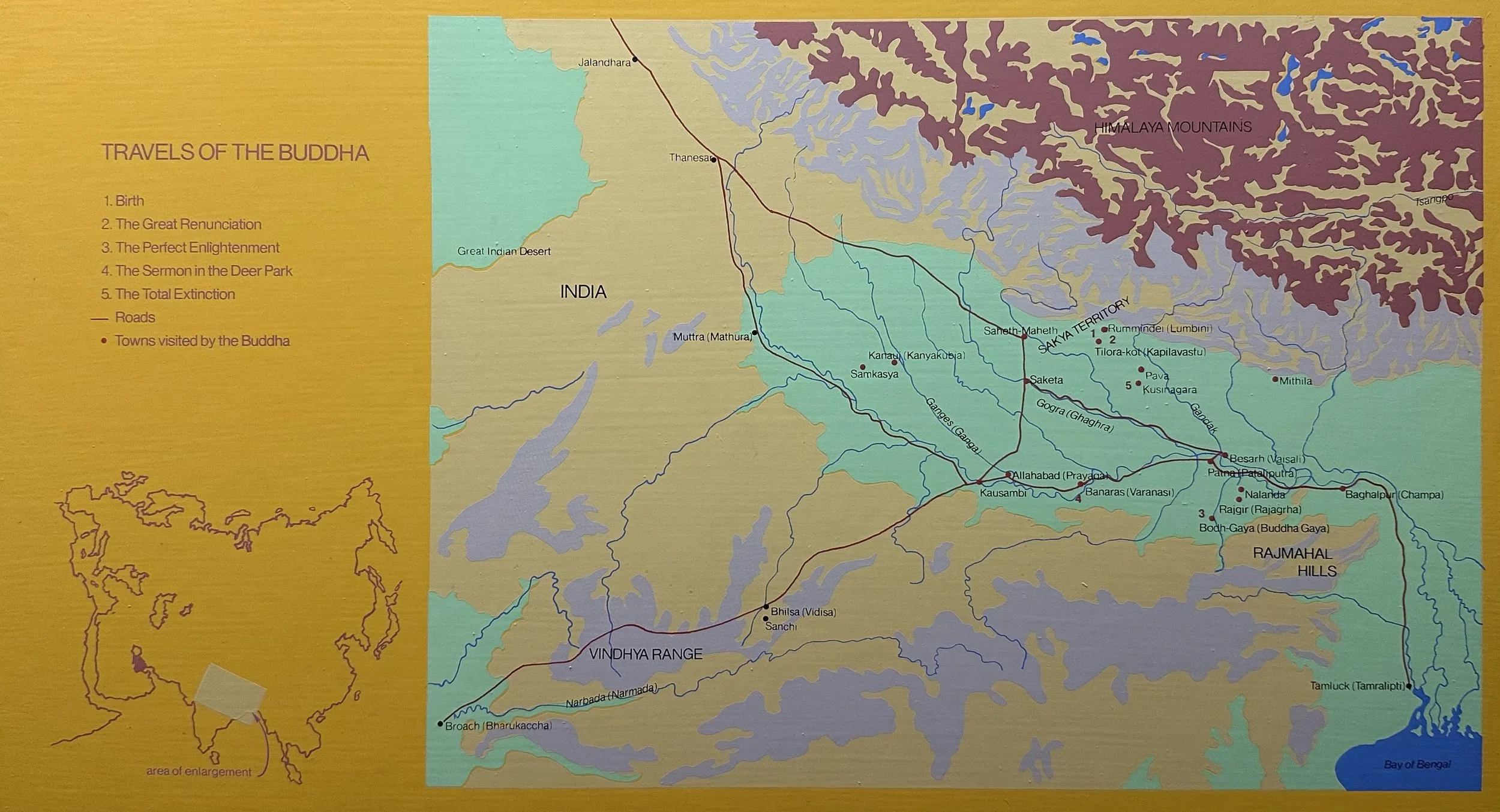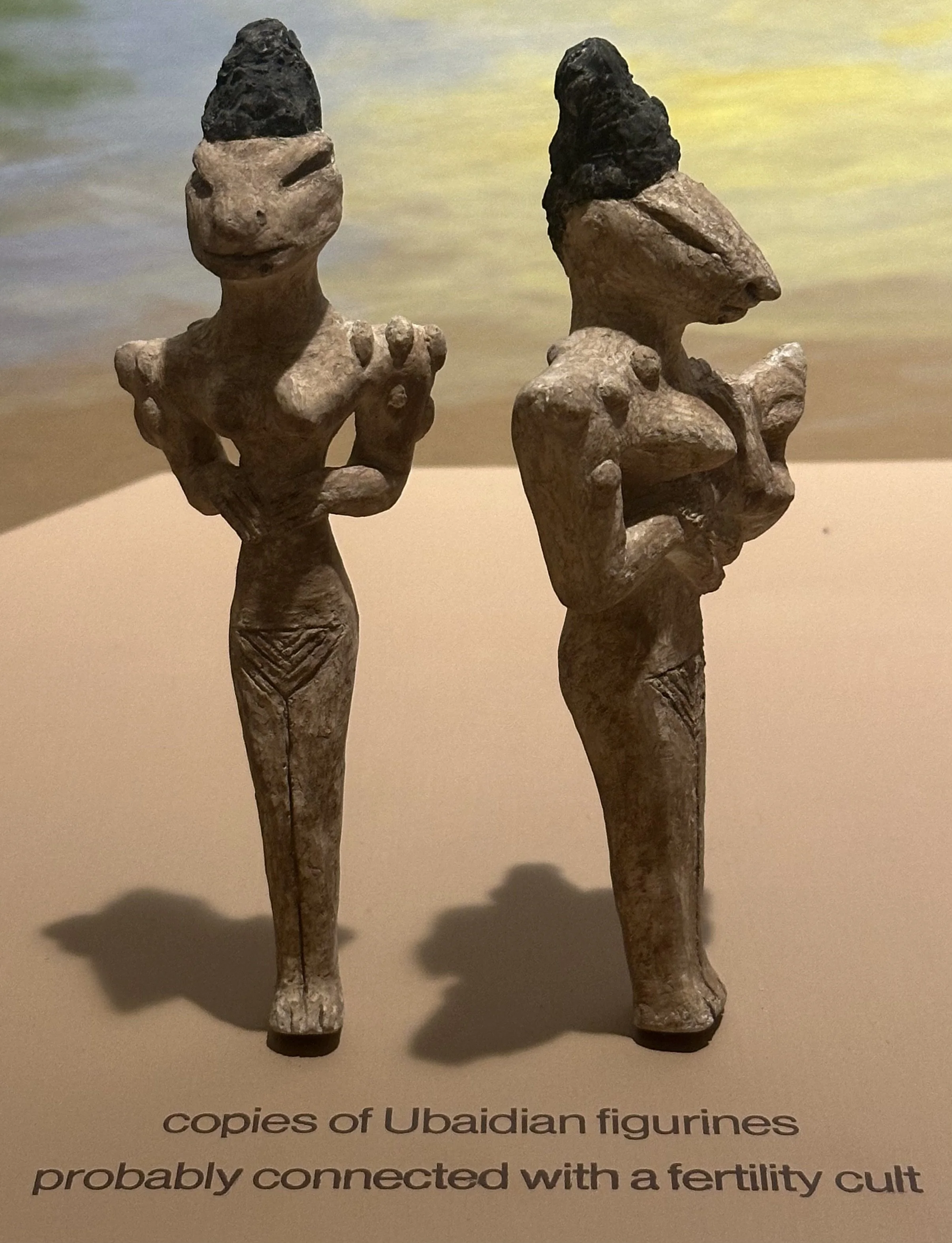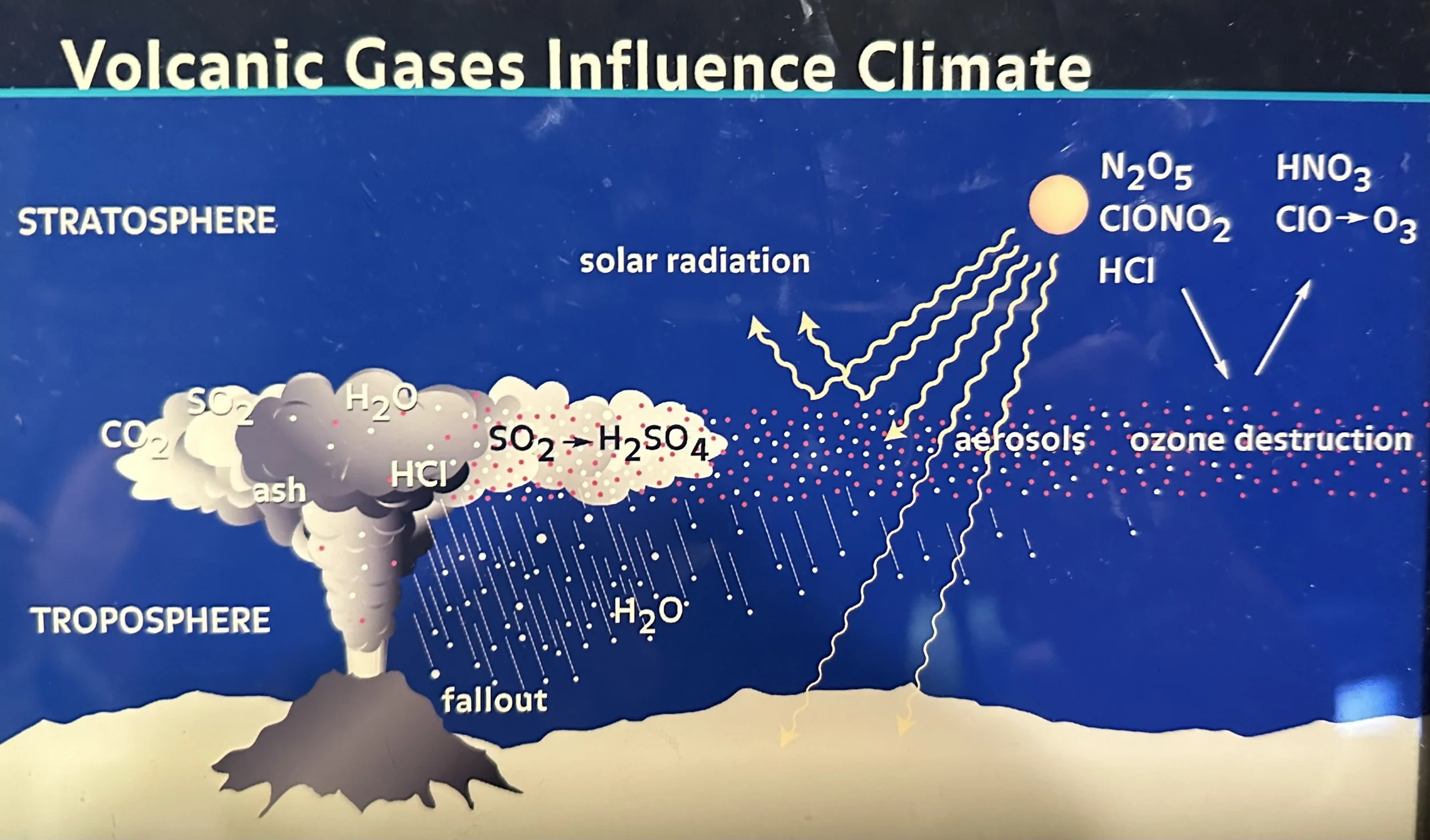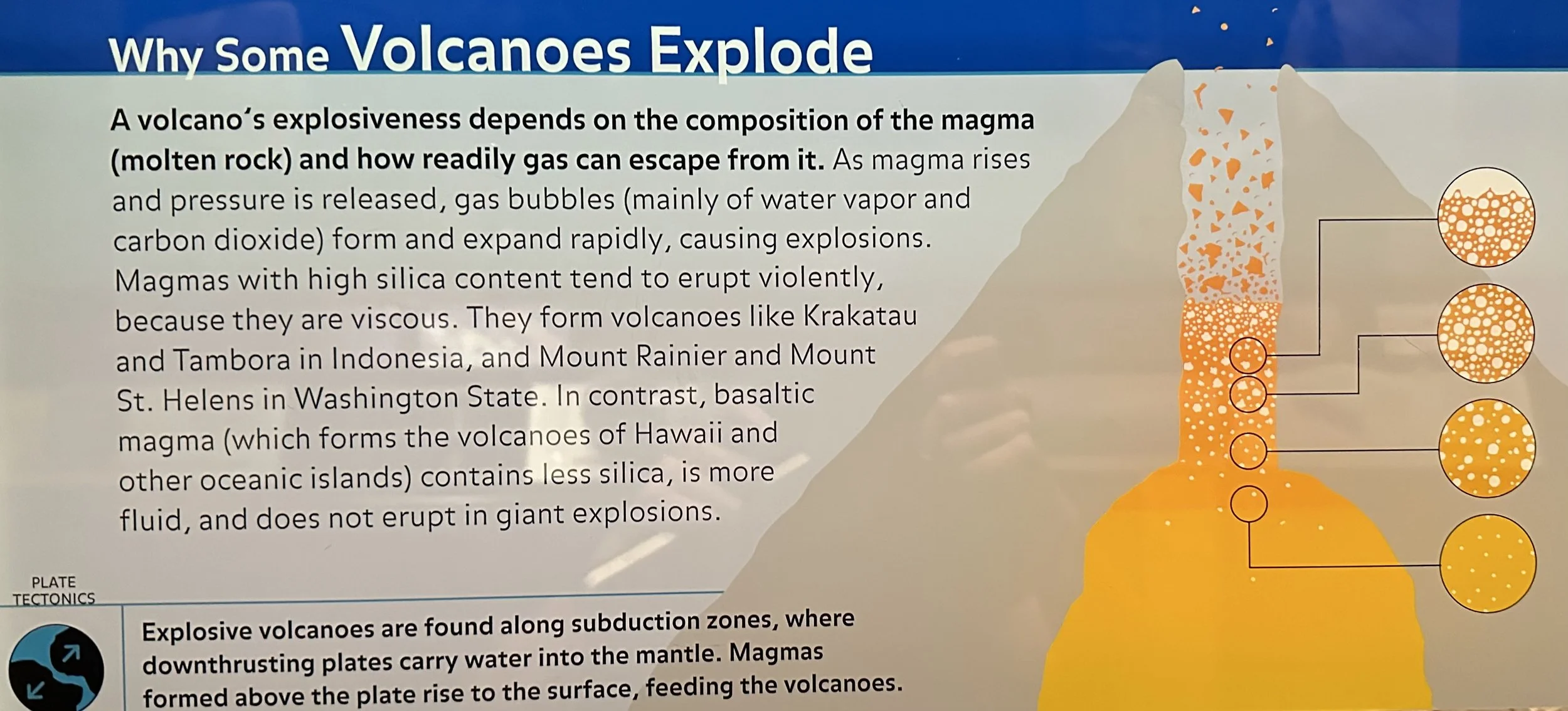American Museum of Natural History
New York City, NY
___________________________________________________________________________
Human Evolution
Animal Evolution: Fish- Amphibians (fins become limbs and walk on land)- Reptiles (with amniotic eggs)- Mammals.
Mammal Orders: Monotremata, Marsupialia, Insectivora, Dermoptera, Chiroptera, Primates, Edentata, Pholidota, Lagomorpha, Rodentia, Cetacea, Carnivora, Tubulidentata, Probiscidea, Hyracoidea, Sirenia, Perissodactyla, Artiodactyla. Primate Families:
Cebidae: Central and Southern American monkeys of small to moderate size. All are arboreal (none are ground-dwellers). Some have prehensile tails. The cebids are divided into six distinct subfamilies, which includes 29 species in 11 genera.
Callithricida: Central and Southern American marmosets; small arboreal monkeys that have long, non-prehensile tails, comparatively large ears for monkeys, and soft hair. Only the first toe of the foot (pes) has a nail and is opposable, all other toes have claws. The front limbs are shorter than the hind limbs. Marmosets have 1-3 young (usually two), travel in family groups, and feed largely on insects but also eat birds, fruits, and seeds. There are 33 species grouped into four genera.
Tarsiidae: Indonesian tarsiers easily recognizable by their large eyes, long hind legs, and disc-like pads on slender fingers and toes. They live in forests and brushy areas, and progress by frog-like leaps from limb to limb. Three species of tarsiers are recognized. They are nocturnal, and feed on insects and other small animals.
Lorisidae: Sub-Saharan African and Indonesian lorises, pottos, and galagos. The lorisiform lemurs of this family are of two types- slow moving, short- tailed, small-eared species and quick, long-tailed, large-eared species.
Daubentoniidae: Aye-Aye lemurs of Africa with rodent-like teeth. Only one species survives that feeds largely on insects. They listen attentively, tap on dead limbs with their fingers, then gnaw into the wood to reach burrows of grubs, which are caught with the extremely slender specialized finger of the hand.
Cercopithecidae: Old World (‘Catarrhine’) monkeys of Africa and Southern Asia. These monkeys are medium-sized primates that have short or long, but not prehensile tails, and that live in trees or on the ground. Their nostrils are usually closer together than American monkeys and their teeth are different. The are divided into two subfamilies, which include 48 living species in 10 genera. Usually only one young is born at a time. They live in groups which usually have a definite social structure. They eat a variety of foods including leaves, buds, fruits, insects, and other small animals.
Pongidae: Apes of African and Indonesia; specialized for swinging by their hands. They have long arms and hands, a wide chest, and no tail. They live in forested areas. The two African species, the Chimpanzee and the gorilla, are largely terrestrial. The ape family is divided into two subfamilies, the gibbons in one and the great apes in the other. There are 8 living species in four genera.
Indridae: Indrisoid lemurs of Madagascar. Lemurs of this family are moderated to large size and are vegetarians, feeding both in trees and on the ground. They leap from branch to branch in an upright position, and climb rather slowly and deliberately. They are often seen in groups from 8-12 individuals. Four species are grouped in three genera.
Lemuridae: Typical lemurs of Madagascar that include 18 species of six genera. Lemurs have lived as long as 26 years in captivity, have acute senses of smell, sight, and hearing, can grunt, shriek (whistle), are of variable temperament.
Tupaiida: Tree shrews of Southern Asia that eat fruits and animals of small size, such as insects. They are diurnal and vociferous. From 1-4 young are born at a time. 15 species are grouped in five genera. The general appearance is that of a long-noised squirrel.
Toolmaking: Man really emerged as such when he began to make tools for specific purposes rather than merely using any piece of rock, bone or wood that came to hand. Toolmaking required intellectual judgment, and a great deal of skill and patience. Africa is important as the earliest known home of stone tools. There we can follow the development from the earliest pebble tools to the later tools and fine stone work found in ancient Egypt. This later work demanded a skill and a sense of craftsmanship that could scarcely be rivalled today.
Hunting & Gathering: Long before man learned to domesticate animals or till the soil, he lived by foraging with only the simplest tools to grub for roots and tubers and hunt game. The economy is such that any one area becomes quickly denuded of edible vegetation as well as game; bands have to be small, nomadic, and able to change in size and composition to suit the needs of the moment. In such a continual state of flux there can be no formal political organization and the family is the only really stable social unit. Such authority as there is falls naturally to family elders, though any major decision comes usually by general agreement of the entire band, each age level having its own responsibilities. Life was probably lived for the ancient hunter, as for the present-day hunter, from day to day. It is this daily economy that holds the hunting band together and gives its members their unity and their purpose in living.
Herding: A way of life that demands regular seasonal movements in search of water and pasture. Herders may congregate in fairly large numbers at certain times of the year, perhaps at a common water-hole, but they have to disperse into smaller groups when water or grazing land becomes scattered. Consequently, as with other nomads, leadership has to be fluid and is confined to small family or regional groups. A priest often exists to perform rites necessary for the health and welfare of the cattle, hence of the people, and frequently he acts as teacher of the young. He may have little authority, but his influence is strong and at least he is a common symbol in whom larger groups can find a source of unity. The cow or bull, while not actually worshipped, acquires in the same way both a religious and a political significance and cattle herders, just because they are cattle herders, feel themselves as a people distinct from all others.
Cultivation: Once man learned to cultivate food crops his whole social life underwent a radical change. The bulk of his tools and utensils made nomadism increasingly difficult, and the discovery of iron also contributed to an elaboration in material culture. Man was forced to settle down in one place to look after his fields, and this in turn meant that he had to formalize his relationships with his neighbors. Legal mechanisms were developed for settling disputes within the local community; larger groups of people, connected by marriage or by some other circumstance, found it convenient to accept a common political head, leading to the formation of tribes and nations. While cultivation as an economy offers much greater rewards, it also invites greater hazards such as drought. To meet these conditions, more formalized religious worship develops, often connected at first to the concept of the fertility of the land and regeneration of life.
Nuclear Theory of Domestication: Groups of animals and plant species which can be domesticated cluster in areas of the world. Asia appears to have at least four such “nuclear” areas including Eastern Central China, SE Asia, Southern Asia, and the near East. The Near Eastern zone indicates the probable movement of food production into Central and Southern Asia, as well as into Europe, after 6000 BCE.
___________________________________________________________________________
Religions
Shintoism: ‘The way of the Kami’; the indigenous faith of Japan. It is based on the recognition and worship of the Kami. Kami can be said to be spirits which are holy and noble. This is to distinguish them from the ordinary spirits which the old traditions of Japan considered to be everywhere in nature. In fact, the line between Shintö and animism is often indistinguishable, especially in older times. Kami can be manifest in trees, rivers, mountains; or it can be qualities of fertility, happiness, order. Kami can be the idea of justice and the blessing of Deity. Kami can be guardian spirits, past heroes and the deceased members of one’s family. Kami can be the way things arrange themselves during events, or as the consequence of rain or sea waves. Kami can be Japan itself. At heart Kami can be defined as all things or qualities that act in harmony with one another.
Islam (al-Islam): “Submission to the will of God.” A Muslim is “one who has submitted to the will of God.” Muhammad brought the message that there is but one God, the everlasting, all-powerful creator and judge. As in Judaism, Christianity and Zoroastrianism, there is a heaven and a hell. Human beings have free will, which makes them responsible for their actions, and they will be judged thereby.
Muhammad (~571-632): The founder of Islam; born to a poor clan of the thriving Quraysh tribe of Mecca. He married Khadija, a wealthy merchant's widow, who had hired him. He became a well-traveled merchant, known for his diplomacy. Given to meditation, he often secluded himself in a cave on Mount Hira outside Mecca, in western Arabia; there, in 610, he heard a voice urging him to “recite in the name of thy lord, who created, created man from a clot of blood. Recite and thy lord is the most bounteous, who taught by the pen, taught man what he did not know.” The voice was later revealed to be that of the angel Gabriel summoning Muhammad to be the messenger of Allah. For the next 22 years, despite strong opposition, Muhammad served as the last prophet of God, with Adam considered as the first, followed by Noah, the family of Abraham, Moses and the prophets of the Old Testament, and finally Christ as the next to last. Muhammad met much resistance as Islam opposed pantheism and threatened belief in the gods housed in the Kaaba. This outlook could jeopardize the interests of all those who came to Mecca to worship their gods and then trade. Vulnerable to attack, Muhammad and a small group of followers fled to Yathrib, later renamed al-Madina (Medina). This Hijra (emigration), in AD 622, marks year 1 of the Muslim calendar. In Medina, Muhammad's diplomacy in arbitrating local conflicts helped to rally more followers to his cause. With them he won several battles and established the legitimacy of his mission. He died in 632, about two years after returning to Mecca in triumph. Muhammad left the ideal that Islam was a community ('umma) of believers which cuts across the specific interests of family, clan, tribe and nation.
Shi’ites: Believe that Ali, last of the four caliphs who ruled after Muhammad died, was his only true successor. Through Ali's wife Fatima, the daughter of Muhammad, they claim direct descent from the Prophet. To the Shiites, Ali was divinely chosen as imam (leader) and thereby became the intermediary between worshippers and God. Historically, the Shi'a itself were divided. The "seveners," with adherents in Egypt and elsewhere, claimed that Ismail, the seventh imam, was the last in the line through Ali's son Husayn. The "twelvers," the main branch of Shia and centered in Iran, claim that the twelfth imam, Muntazar (d. 878), a descendant of Ismail's brother Muza, was the last imam. Persecuted by Sunni followers, each Shi'a sect conceived that its last imam went into hiding. Followers of Mahdiism believe that the "hidden imam" will return as Mahdi (divine guide) to save them and bring peace and justice to the world. Shi'ites number ~15% of the Islamic faithful.
Sufism: An increasingly popular school of thought in Islam, stresses individual experience of and personal relationship to God: "Love God and God will love you." Unity with the divine is sought through prayer, meditation and trance induced by chanting or dancing. As organized by al-Ghazali, the Sufi (one who wears wool), who lived 1058-1111, Sufism has produced some of Islam's greatest thinkers and literary figures.
Ash’arite: Most Muslims follow a school of orthodox thinking founded by Ali al-Ash'ari (d. 935). The problem of free will versus the will of God involves the paradox: "if God creates man and directs human actions, how can man be punished for obeying God's will?" Emphasizing the specific experience of Muhammad with God, the Ash'arite system postulates that what is foreordained can be met rightly or wrongly: man's responsibility is to know the right way.
Buddhism: According to ancient Indian belief all living things are a part of a chain of causation which moves the individual from one life to the next according to an immutable law (karma). One's particular life at any given time depends chiefly on how well one has lived in a previous time; whether, for example, the individual had been essentially good or bad. This chain of causation is sometimes depicted as a wheel. Buddhist doctrine (the way) provides a method for escaping the cycle of causation. The Buddhist way is based upon the Four Noble Truths:
1) All living things subject to the laws of causation undergo different degrees of suffering. No one can escape the effect of one's own emotions, desires and ambitions. Thus, suffering exists.
2) Suffering is caused by self-centered desire.
3) Suffering can be made to cease.
4) Suffering can be made to cease by following the Eightfold Path.
To understand the meaning of the Eightfold Path, one must realize that in the whole spectrum of human emotion, desire and ambition, those who go to extremes suffer the most. In consequence the Eightfold Path instructs man to live with moderation and to avoid extremes. The Eightfold Path consists of right views, right work, right resolve, right effort, right speech, right mindfulness, right action, right concentration. All of these precepts stress that emphasis upon self is not right. In other words, an awareness of others and of the laws of nature makes possible a reasonable life.
The Four Noble Truths and the Eightfold Path make up the Dharma, or Buddhist law. If one follows that law, in the end the chain of causation can be overcome, and a state of non-suffering, or Nirvana, could be achieved.
Hinduism: The religion of India, followed by most present-day Indians. It is an all-pervasive way of life which affects nearly every aspect of the Indian world view. Historically, it appears to have arisen as a combination between ancient Indo-Aryan worship, brought to India in the second millennium B.C., and local animistic conceptions of deity in nature. It has passed through numerous phases. The most recent involves worship of a pantheon of deities dominated by Brahma, an ultimate creator; Siva, sometimes called the Destroyer, but paradoxically also a creator, as one of his forms, the phallus, demonstrates; and Vishnu, the Creator, who in his various avatars, or incarnations, exercises control over disorder. The many sects of Hinduism range from strict deism to the highly esoteric.
Christianity (Armenian): Rejects the concept of purgatory, does not admit the papacy, allows clergy to marry before ordination; the liturgy is in ancient Armenian, and there are other differences from Roman Catholic practice. But the sacraments of Armenian and Roman Catholic Christianity are essentially the same. However, the Armenian Church is monophysite: that is, it upholds the belief that Christ was not human and separately divine, as believed in most sects of Christianity, but had a single, composite nature-"perfect man and God at the same time."
Confucianism: Centers on the concept that nature itself represents order in the world, and human society should accordingly mirror that order. Confucius set forth five basic relationships essential to the proper functioning of society; all require respect and obedience as the tenets of mutual responsibility. They can be classified as biological: husband- wife, father- son, elder brother- younger brother; social: friend to friends; political: authority to subject.
___________________________________________________________________________
Central America
Teotihuacan:
Toltec: After the fall of Teotihuacán, no large culture centers flourished in Central Mexico until about 200 yrs later with the rise of Tula, a site clearly identified as the home of the Toltec. According to Aztec legend, the Toltec were the Aztecs' ancestors, revered as heroes of a golden age, powerful men and great inventors. These legends became part of historical accounts written by the early Spaniards in Mexico. Like the Aztec, the Toltec spoke a form of Nahuatl. Tula existed from ~900-1200, the center of a tribute empire similar to that later founded by the Aztec. That Tula dominated in other regions is clearly indicated not only by legendary Maya accounts but also by the remarkable similarity of Tula's architecture and sculpture to that of distant Chichen Itza, in Yucatan. In its origin, the architectural style of Tula blended ideas from Teotihuacán with elements from the Classic Maya and other regions of Mexico.
Huasteca: A region in NE Mexico occupied in ancient times and still inhabited in part by the Huastec Indians who, although remote from centers of Maya culture, speak a Maya language. Numerous archaeological sites occur in the region, particularly along the Pánuco River and its tributaries where rich alluvial soil provides excellent agricultural land. Notable in the architecture is an emphasis on round buildings. The Aztec knew the Huastec as fierce warriors whom they could not subjugate and bring into their tribute empire. Perhaps for this reason, the Aztec considered them to be somewhat primitive and uncivilized, although, as with the Aztec, their principal deity was Quetzalcoatl.
Oaxaca: Lying between Central Mexico and the Maya area, and also close to the major centers of the Gulf Coast, the central valleys of Oaxaca played an important role in the growth and achievements of Mesoamerican civilization. Oaxaca was a vital center and maintained its particular style of artistic expression for at least 2,000 years. Two peoples speaking distinct languages, Zapotec and Mixtec, occupied most of the state of Oaxaca and certainly account for the major remains. Monte Albán was built primarily by the Zapotec but, like Mitla, it was occupied in later times by the Mixtec. There are many other sites, too.
Guerrero: A central American state occupied throughout the full range of Mesoamerican history. This inference is based primarily on the influences from other major cultural centers that can be seen in many objects from Guerrero. Numerous Olmec or Olmec-influenced small sculptures have been found suggesting dates of occupation as early as 1000 BCE Belonging to the Classic Period are obvious influences from Teotihuacán and some from the Maya region; still later, the Aztec left an impression of their style.
Olmec: Centered in the tropic lowlands of the Gulf coast region, the Olmec culture holds special importance in Middle American archaeology. As the earliest manifestation of a degree of development that can be called civilization, it is generally considered, in a sense, the mother culture of Middle America. Only recently has this culture become known; important and surprising discoveries are being made yearly, but much remains to be learned about its nature and origins. The Olmec are identified primarily by their special art style expressed in mammoth stone sculptures and small carved objects of jade and other fine stones. Recent studies have shown that their culture flourished as early as 1200 BCE and lasted until about 600 BCE, but excavations have not yet revealed how the Olmec reached this advanced level. Although earlier ceramic-using cultures existed in Middle America, evidence has not been found of the developmental stages leading to the complex society indicated by the stone sculptures and large structures created by the Olmec.
___________________________________________________________________________
India
Mughals: A dynasty of Turko-Mongol ancestry, originally lived around Samarkand. Driven out by the Uzbeks, they eventually moved into India under their leader Babur, the first Mughal emperor, and conquered much of northern India (1526). For the next 200 years the Great Mughals ruled much of India. Midway through this period the first British ambassador reached the Mughal court and instituted the trade agreements which eventually led to British domination. The last Mughals, weak and ineffective, lost their empire to Britain in 1858. Many of the splendid Mughal achievements in India represent the final flowering of Islamic civilization. They include developments in Islamic-Hindu law, astronomy, Sufism, painting, architecture including the Taj Mahal, and in literature. The Mughals laid the foundation for the modern state of Pakistan.
___________________________________________________________________________
South America
Slavery in South America: Unlike the slaves exported to North America, those sent to South America were often kept together in tribal groups. Just as the policy in the north was to prevent unified uprisings by destroying traditional bonds, forcing the slaves to speak English as the only common language, so in South America maintaining tribal divisions and actively fostering tribal hostilities thwarted united insurrection. In some areas owners even sponsored annual festivals, during which each tribal group was expected to demonstrate its superiority in activities such as dance or music. However questionable the motive, the result was that even today certain very specific African cultures still thrive on the southern continent.
Tawantinsuyu: “Realm of four parts” (Quechua); describes the realm governed by the Inka. The name conveys the idea that the huge territory under Inka dominion was a set of linked divisions. Unequal in size, each of these divisions included many different peoples. A road network extending > 23,000 km connected the divisions to Cusco. Local people retained varying degrees of independence.
___________________________________________________________________________
Africa
Africa and Slavery: Much of what is loosely termed "slavery" in Africa was, in fact, serfdom, a more humane institution and primarily a way of dealing sensibly with war captives and criminals. They were put to work, and gradually could secure for themselves and their descendants a full and honorable place in society. Even after Arab and European slave traders introduced real slavery, many African rulers at first treated their slaves with respect. But the coastal slave trade soon spread corruption and greed, and thousands of Africans were caught and sold into a form of slavery that, as practiced in the New World, outdid anything ever known in Africa. The slaves, however, or those few who survived, brought with them something of Africa — a "some-thing" that enabled them to survive the psychological horrors following the physical horror of the "middle passage." Thus, the African tradition was exported to the Americas.
African Masks: A mask may be designed to convey a certain feeling of awe, respect or humor. Or it may derive its character from that of the owner. Most, if not all, masks belong to a total costume concealing the wearer's identity, so that his actions are not taken personally. Especially in the case of masks worn by judges, as with the wigs or robes Western judges wear, the idea is that society itself, not the individual, passes judgment. A mask may condemn a murderer, extract compensation from a thief, bless the fields, secure wartime protection or ridicule minor offenders, but no one man has the right to judge others. All authority is held and all judgment given in the name of the ancestors. Some masks represent the founding ancestor; other "portrait masks" recall great people more recently dead. Some are totemic or stand for certain animal qualities needed on given occasions.
Niger: Gold was as central as agriculture to African civilizations, such as Ghana, Mali and Songhai, that arose in the bend of the Niger River. Far distant from its modern namesake, ancient Ghana was founded in about the 4c. in the same area where African agriculture perhaps first began. But it was for the magnificence and power of its court that Ghana became famous. Regarded as semidivine and officially attended by his mother and sister, the king had a monopoly of Ghana's gold and used it lavishly. During medieval times the Niger kingdoms reached a peak of splendor, dazzling even the Arab world. From the headwaters of the Niger to its mouth, where similarly great states, such as Benin and Ife, developed, the ancient kingdoms were famed not only for gold but for learning, hospitality, courtesy and justice. Behind the facade of autocratic kingly rule lay an essentially democratic political system.
Sahara: Saharan rock paintings show startling evidence of roaming elephant, giraffe and rhinoceros, pursued by man. Ecologically, the Sahara Desert now differs profoundly from the Maghreb, the northerly tip of Africa where heavier rains bring a Mediterranean vegetation. Studies based on pollen analysis reveal that this vegetation has at times spread over most of the Sahara. There are abundant traces of manmade tools from very early periods onward in places now uninhabitable. A hunter for most of the prehistoric period, man gradually turned to nomadic cattle-herding after about 6000 BCE. In the southern Sahara, people dependent on fishing settled around lakes now vanished, leaving behind their bone harpoons and fishhooks. By 500 BCE, present desert conditions had engulfed the Central Sahara, only the oases supporting life, but the Maghreb survived.
___________________________________________________________________________
Trade
Early Trade Items: Curry powder, chili peppers, camphor, nutmeg, coriander, frankincense, cloves, cardamom, Pearls, Ruby’s, Saffron, Tea, Cinnamon, Snuff, Cumin seeds, Ginger, asafetida, turmeric root, black pepper, sandalwood, mace, opium.
___________________________________________________________________________
Ecology
Food Web: Solar Radiation- Producers- Consumers (Omnivores & Herbivores)- Consumers (Carnivores).
Green Algae: Contain firm cell walls, often composed of complex sugars such as cellulose. Like land plants and certain bacteria, green algae have the pigment chlorophyll to convert the sun's energy into food and O. The structure of green algae is much simpler than that of other groups of plants. They may consist of a single cell or many cells, and may form colonies, long strands, or other structures. Some even have flagella, enabling them to swim. The ancestors of the plant kingdom were multicellular green algae.
Archaebacteria (‘ancient’ bacteria): More similar to advanced forms of life than to the "true" bacteria. They have unique internal chemical pathways characteristic of life at the extremes, and perhaps of the earliest life on earth.
Thermophiles (‘heat lovers’): Live at very high temperatures, such as are found in hot springs.
Methanogens: Cannot tolerate oxygen, and obtain their energy by converting CO2 to CH4 gas. CH4 combines with O to form CO2, keeping the atmosphere's O level stable and preventing outbreaks of uncontrolled wildfires.
Bacteria: The simplest of all organisms. They are incredibly abundant: >10M live in a pinch of garden soil, and billions live in every animal's body. Bacteria rule the earth, performing a diverse array of functions that make life possible for humans and other species. They produce O through photosynthesis, promote digestion, and cycle N, C, S, and other elements through the world's ecosystems. Though some bacteria cause disease, without bacteria nothing else could live.
Protoctista: A very diverse group of single-celled or simple multicellular organisms that have complex eukaryotic cells- cells whose DNA is in chromosomes in the cell nucleus. Some protoctists are like plants, converting the sun's energy into O by photosynthesis. Others are like animals, eating bacteria and fellow protoctists. Still others feed on dead organisms. Some shelled protoctists - for example, the planktonic foraminifera, which float near the ocean's surface- help to regulate the cycling of C through the earth's ecosystems.
Diatoms: Among the most plentiful of aquatic organisms, form the base of many marine and freshwater food chains. They manufacture their own food via photosynthesis, turning CO2 from the air into sugars that are then taken up by other organisms. Diatoms are responsible for 20-25% of all such C assimilation. C-rich diatom shells and animal remains accumulate at the bottom of the ocean, forming a C "sink" that stores vast amounts of C away from the atmosphere.
Cyanobacteria: One of the few groups of organisms able to convert N from its inaccessible atmospheric form into organic forms that can be taken up and utilized by plants and other creatures.
___________________________________________________________________________
Chronology
7 Dec, 1988: A 6.8M earthquake strikes Armenia, resulting in the deaths of 25K people, most due to a lack of earthquake-resistant engineering. (American Museum of Natural History).
19 Sep, 1985: An earthquake strikes near Mexico City severely damaging much of the city (American Museum of Natural History).
1976: An earthquake strikes T’ang Shan, China, resulting in the deaths of ~250K people, most due to a lack of earthquake-resistant engineering (American Museum of Natural History).
1 Apr, 1946: Hilo, Hawaii is struck by a large tsunami caused by sudden vertical movements of the seafloor, destroying most of downtown Hilo (American Museum of Natural History).
18 Apr, 1906: The great San Francisco earthquake produces a surface rupture ~300 km long (American Museum of Natural History).
1858: The last Mughals lose their empire to Britain (American Museum of Natural History).
1815: Volcanic eruption of the Tamboro volcano in Indonesia (the largest in 20K yrs). Ash fell on Java almost 500 km away, and tens of thousands of people died of famine after ash covered all crops and water sources. The year 1816 became known as the “year without a summer”- a period of snowfalls and deadly summer frosts in areas of Europe and N. America (American Museum of Natural History).
1587-1629: Reign of Shah ‘Abbas over the Safavid Empire (modern Iran) (American Museum of Natural History).
1542: Amazonia is first traversed when Spanish explorer Francisco de Orellana travels down the length of the Amazon, claiming that during one encounter with Indians his men were attacked by fierce warrior women who reminded him of the Amazons of Greek legend. Thus, the river got its name (American Museum of Natural History).
16 Nov, 1532: Spanish conquistador Francisco Pizarro and his men meet Inkan King Atawallpa in the Inka city of Cajamarca (modern Peru). Atawallpa, recently victorious in a dispute over rulership, was taken hostage. A few months later, despite delivering on one of the richest ransoms in history, he was killed. The upper levels of native Andean organization withered quickly under Spanish control, but the lower levels survived, especially in isolated places (American Museum of Natural History).
1526: The Mughals led by Babur conquer much of N. India. For the next 200 years, the Great Mughals rule much of India (American Museum of Natural History).
1500: Portuguese navigator Pedro Alvarez Cabral is blown off course en route from Lisbon to India and lands on the coast of Brazil. There he meets briefly with the Tupinamba, but was unaware they were cannibals. This was the first known contact between Europeans and Amazonian Indians (American Museum of Natural History).
1293-1389: The Philippine islands, Melanesia, and Northern Australia are united under the Majapahit Empire (American Museum of Natural History).
1000: Invention of the magnetic compass under China’s Song dynasty (American Museum of Natural History).
1000: Invention of the game of dominoes under China’s Song Dynasty (American Museum of Natural History).
900-1100: Sican culture on the N. coast of Peru flourishes, achieving unprecedented production of metal goods. Using collective labor, Sican builders brought back the Moche tradition of monumental pyramids. High-ranking people were buried nearby in tapered shaft tombs, some over 20m in depth, and were often accompanied with an immense number of valued goods, most notably gold objects (American Museum of Natural History).
7c: Mahayana Buddhism is practiced in Japan. The Mahayana form, which holds that there are many Buddhas representing the worlds of past, present and future, and Bodhisattvas who act as intermediaries in securing good relations between worshippers and the Buddhas. This Buddhism generated a number of sects and was instrumental in inspiring great art and architecture in Japan. The mandala ranks among the most significant of the art forms (American Museum of Natural History).
600-1000: Wari thrives as one of the largest settlements ever built in native S. America. Covering 4-5 sqkm, it appears to have been an urban center dominating most of central and southern Peru. Sites such as Pikillaqta, near Cusco, and Wiraqocha Pampa in the northern Peruvian highlands show some of the same architectural features as Wari and may have been outposts to establish Wari control in distant areas. These centers and the use of khipus - knotted cords - for standardized record keeping suggest that Wari had an elaborate political and economic organization that foreshadowed the later Inka state (American Museum of Natural History).
~571-632: Life of Muhammad, the founder of Islam; born to a poor clan of the thriving Quraysh tribe of Mecca. He married Khadija, a wealthy merchant's widow, who had hired him. He became a well-traveled merchant, known for his diplomacy. Given to meditation, he often secluded himself in a cave on Mount Hira outside Mecca, in western Arabia; there, in 610, he heard a voice urging him to “recite in the name of thy lord, who created, created man from a clot of blood. Recite and thy lord is the most bounteous, who taught by the pen, taught man what he did not know.” The voice was later revealed to be that of the angel Gabriel summoning Muhammad to be the messenger of Allah. For the next 22 years, despite strong opposition, Muhammad served as the last prophet of God, with Adam considered as the first, followed by Noah, the family of Abraham, Moses and the prophets of the Old Testament, and finally Christ as the next to last (American Museum of Natural History).
375-1000: Tiwanaku (modern Bolivia) S. of Lake Titicaca at ~13,000’ on the Andean high plateau thrives as a major ceremonial center with massive pyramids, temples and elaborate stone sculpture. Tiwanaku was also a sizable city, with a surrounding agricultural area and satellite towns. It controlled or strongly influenced distant areas in Bolivia, southern Peru and northern Chile (American Museum of Natural History).
330: The Georgian state adopt Christianity (American Museum of Natural History).
301: Armenia is the first state to adopt Christianity after Gregory the Enlightener converts Armenian King Tiridates III (American Museum of Natural History).
224-635: Zoroastrianism flourishes in Iran under the Sassanians, but declines after the Islamic conquest. To avoid persecution many Zoroastrians (Parsees) flee to Bombay and other Indian cities where ~100K survive today (American Museum of Natural History).
200: The Japanese islands are invaded by a people from Mainland Asia who use iron, ride horses and are divided into special clans. Apparently led by powerful warriors, the newcomers conquer much of Southern Honshu (American Museum of Natural History).
73: Roman forces besiege and capture Masada. The day before victory, all the remaining rebels- nearly 1000 men, women, and children, take their lives rather than submit (American Museum of Natural History).
70: Roman forces sack Jerusalem. Jewish rebels hold out on the Masada plateau, some 50km south, at the eastern edge of the Judean wilderness. The Diaspora, the great scattering of the Jewish people, begins. Most eventually reach Europe and establish two major divisions of Judaism, the Ashkenazim of Eastern Europe and the Sephardim of Spain. Judaism coupled with Christianity provided the ethical base upon which western civilization stands (American Museum of Natural History).
1-700: Teotihuacan, ~40km NE of Mexico City, is a major city and cultural center in Middle America. Teotihuacan influenced various other cultures, including that of the distant Maya. It’s size, its massive pyramids and large palaces more clearly reflect a highly complex urban society than does any other Middle American archeological site of the same period. Teotihuacan was probably the capital of a tribute empire similar to the one later maintained by the Aztecs. After a peaceful existence for centuries, Teotihuacan apparently suffered violent destruction by invaders (American Museum of Natural History).
4c BCE: Chopsticks and the crossbow are invented in China (American Museum of Natural History).
500 BCE: Present desert conditions engulf the Central Sahara (American Museum of Natural History).
563 BCE: Birth of Siddhartha the Buddha to be in Kapilavastu, the son of the Sakya king Suddhodana and his wife Maya. Until the age of 29 he lived as a young Indian prince surrounded by great riches and beautiful gardens. Then for the first time he saw old age, sickness, and death, and began to ponder the state of the world (American Museum of Natural History).
575 BCE: Life of Zoroaster (Zarathustra), a priest of the ancient polytheistic religion of Iran. According to legend, a vision of the wise lord, Ahura Mazda, inspired him to preach that Ahura Mazda was the high god who loved goodness and justice in the form of hymns (gathas), later became part of a collection of texts known as the Avesta, which direct and teach the Zoroastrian cosmology and way of life. For Zoroastrians, the world is an arena where the forces of good (Ahura Mazda) contend with the forces of evil (Ahriman). In the end the forces of good will overcome evil, and there will be a time of judgement when the dead will have to cross a cosmic bridge- the bridge of the Requiter. Evil souls will fall from the bridge to hell while the good will cross into Paradise (American Museum of Natural History).
605-562 BCE: Reign of Nebuchadnezzar over the Babylonian Empire; the city reaches its zenith (American Museum of Natural History).
900-200 BCE: The highland center of Chavin de Huantar flourishes. Religious symbols in Chavin stone sculpture featured tropical rain forest animals: the jaguar, crested eagle, caiman, snake and monkey. Other central Andean societies adopt the Chavin cult. Revolutionary technical innovations are seen in metal objects and textiles made for use in rituals. Long-distance exchange of items like obsidian and shell also expands. The widespread sharing of religious images, technology, ceramic style and architectural plans reflect a broadened sense of social identity; an Andean tradition emerges, uniting previously unrelated cultures of the highlands and the coast (American Museum of Natural History).
1122-221 BCE: The Chou dynasty reigns in China’s classical age. In this period, military and craft arts develop as does writing. Peace prevailed during the early Chou dynasty, but turbulence marked its close, the period of the warring states (American Museum of Natural History).
1150 BCE: The Trojan war (American Museum of Natural History).
1500 BCE- 1: Middle America’s Pre-Classical period. It is characterized by firmly established village settlements based on agriculture with maize, beans and squash as the principal plants, and by a well-developed ceramic industry. It precedes the appearance of major architecture and of the large city states which everywhere mark the succeeding Classic Period. During the Pre-Classic, it was only in the Olmec region of Gulf coastal Mexico that these latter developments took place, and Olmec influence can be seen from an early time in the Pre-Classic of Central Mexico (American Museum of Natural History).
2000 BCE: Corn, cultivated in Mexico, first appears in the Andes (American Museum of Natural History).
3000 BCE: Village farming is well established in Tripolje, Russian Ukraine (American Museum of Natural History).
3100 BCE: The Dawn of civilization; the Sumerians establish an empire on the plain of Shinar in SE Iraq (American Museum of Natural History).
4000 BCE: Sedentary life based on agriculture appears on the alluvial plains of N. China. Basic food resources included staple cereals grown by means of hoe agriculture and domesticated sheep, pigs, and possibly cattle. Two distinct and generally parallel cultures are known: the Yang Shao, typified by painted pottery, and the Lung Shan, or Black Pottery culture. Late, Chinese farmers moved west and south to the Yangtze River and beyond (American Museum of Natural History).
4500 BCE: Village farming moves into India (American Museum of Natural History).
4500 BCE: Village farming spreads along the upper Danube basin into Northern Europe, flourishing especially in southern Germany and the Low countries. Similarly, farming villages develop in the Russian Ukraine (American Museum of Natural History).
5000 BCE: Near Eastern Agriculture flourishes in the region of modern Budapest to the Black Sea (having spread throughout from Thessaly) (American Museum of Natural History).
5000-4000 BCE: Foragers first arrive in the Greater Antilles islands from South or Central America and remain in isolated areas until the European conquest (American Museum of Natural History).
6500 BCE: Village farming moves into the Iranian plateau and Central Asia while a similar type of farming, Near Eastern Agriculture, began in the SE Balkans, especially in Thessaly, which spreads from there into the Danube Valley. Typically, loosely knit villages made up of single-family houses stood among cultivated fields. Farming was so successful and the soils so fertile that people could live in the same village locales for a 1000 yrs or more (American Museum of Natural History).
10 Ka: Extinction of large glacial-age mammals in S America. At the time, Andean farmers were cultivating common beans, lima beans, and chili peppers, probably on the E. slopes of the Andes where their wild ancestors grow (American Museum of Natural History).
~11 Ka: Village life based on farming and the domestication of animals begins in the Near East (American Museum of Natural History).
16-5 Ka: The Great Transition (Mesolithic of Europe); glacial ice retreats Northwards changing the regions from tundra to forest. By 8300 BCE (10.3 Ka), open woodland covers much of N. Europe. The descendants of the Magdalenian hunters and gatherers of the upper Paleolithic survived in France, Spain, Italy, and Southern England. The reindeer hunters spread into Northern and Western Europe, where they adapted to differing environments by hunting deer, gathering hazelnuts, and harpooning fish (American Museum of Natural History).
18-11.5 Ka: Humanities Magdalenian period (American Museum of Natural History).
21-18 Ka: Humanities Solutrean period (American Museum of Natural History).
27-22 Ka: Humanities Gravettian period (American Museum of Natural History).
28 Ka: Beginning of the Gravettian phase of Ice age culture, which extends from Spain to Siberia. Archaeologists mark 22 Ka as the end of the Gravettian period in some parts of France and Spain, but in regions to the East, similar art forms continued to be made until about 10 Ka, in a cultural period known as the Epigravettian (American Museum of Natural History).
35-29 Ka: Humanities Chatel Perronian period (American Museum of Natural History).
40 Ka: Humans have achieved a cognitive understanding with a possible believe in afterlife and in spiritual qualities inherent in nature (American Museum of Natural History).
60 Ka: Aboriginals first occupy Australia (American Museum of Natural History).
200-30 Ka: Life of Homo sapiens neanderthalensis. They had brains as large as ours and were outstanding toolmakers. Neanderthals dominated Europe and parts of W. Asia until their lineage died out <30 Ka (American Museum of Natural History).
300-80 Ka: Peking Man (H. erectus) lives in Peking in 50-60 person groups (American Museum of Natural History).
1.6 Ma-12 Ka: Pleistocene period (American Museum of Natural History).
1.7 Ma: Life of Paranthropus robustus, an early hominid, in Southern Africa (American Museum of Natural History).
5.3-1.6 Ma: Pliocene period; the earliest hominids appear (Australopithicus) (American Museum of Natural History).
23.7-5.3 Ma: Miocene period; the Red Sea opens and the Alps begins to form. The saber-toothed cat (Smilodon) first appears (American Museum of Natural History).
36.6-23.7 Ma: Oligocene period; the primitive dog (Cormocyon) first appears (American Museum of Natural History).
50 Ma: Sea cows evolve (American Museum of Natural History).
55 Ma: Horses evolve (American Museum of Natural History).
56 Ma: Paleocene-Eocene Thermal Maximum (PETM); thousands of GT of C enter Earth’s atmosphere in roughly 20K yrs, causing global temperatures to rise 4-5 C. Warm conditions profoundly change life on Earth and lasts tens of thousands of years. It then takes ~80K yrs for the climate to cool (American Museum of Natural History).
57.8-36.6 Ma: Eocene period; India collides with Eurasia and begins forming the Himalayas, the primitive horse appears (Orohippus) (American Museum of Natural History).
66.4-57.8 Ma: Paleocene period; mammals flourish (Leptictis) (American Museum of Natural History).
135 Ma: South American and Africa split apart, erupting huge amounts of basaltic lava (American Museum of Natural History).
144-66.4 Ma: Cretaceous Period; Pterosaurs (flying reptiles) flourish (Nyctosaurus), South America separates from Africa, flowering plants appear, and the period ends with the KT-extinction of the dinosaurs (American Museum of Natural History).
208-144 Ma: Jurassic period; the Atlantic Ocean begins to form as North America drifts away from Africa and Europe. Dinosaurs flourish and birds evolve from dinosaurs (Archaeopteryx) (American Museum of Natural History).
245-208 Ma: Triassic period; seed bearing plants and conifers flourish, the first dinosaurs appear (Plateosaurus), and the first mammals appear (American Museum of Natural History).
260 Ma: Formation of the Kaibab Limestone on the modern CO plateau during an advance of the sea (American Museum of Natural History).
270 Ma: Formation of the Toroweap sandstone when the area, the western shoreline of North America, advances and retreates many times, depositing sands and limestones (American Museum of Natural History).
280 Ma: Formation of the Coconino Sandstone when the area was a vast desert upon which layers of wind-driven sand dunes accumulate (American Museum of Natural History).
286-245 Ma: Permian period; Supercontinent Pangaea stretches from pole to pole; the Tethys Ocean forms as Asia and Africa split. Early sharks (Helicoprion) and the early relatives of mammals (Dimetrodon) first appear (American Museum of Natural History).
~350 Ma: Amphibians first walk on land (American Museum of Natural History).
360-325 Ma: Formation of the Redwall Limestone when the area, the western shoreline of North America, advances and retreats in a slow rhythm, depositing layer after layer of sediment (American Museum of Natural History).
360-286 Ma: Carboniferous period; the Appalachian Mountains form, extensive coal beds form from the remnants of swamps and forests, reptiles evolve from amphibians and develop an amniotic egg with a protective cover (Hylonomus). By the end of the Carboniferous, glaciers cover extensive areas of continents which diminishes coal-forming forests (American Museum of Natural History).
408-360 Ma: Devonian period; the length of a day is ~21-22 hrs, predatory fishes with jaws flourish (Eastmanosteus), the first amphibians evolve from fish (Acanathostega), insects proliferate (Rhyniella) (American Museum of Natural History).
438-408 Ma: Silurian period; what will become Africa is located at the South Pole; the equator runs through N. America, Greenland, and Europe. Early land plants first appear (American Museum of Natural History).
505-438 Ma: Ordovician Period; supercontinent Gondwana contains most of Earth’s continental crust, appearance of the first vertebrates and primitive fishes (Astraspis), shelled organisms flourish (American Museum of Natural History).
550 Ma: Formation of the Tapeats Sandstone, the first sedimentary layer deposited on the modern CO plateau, when the area lay along the beach of an ancient shoreline (American Museum of Natural History).
560-505 Ma: Cambrian Period; life rapidly proliferates and diversifies including early shelled organisms (American Museum of Natural History).
___________________________________________________________________________



